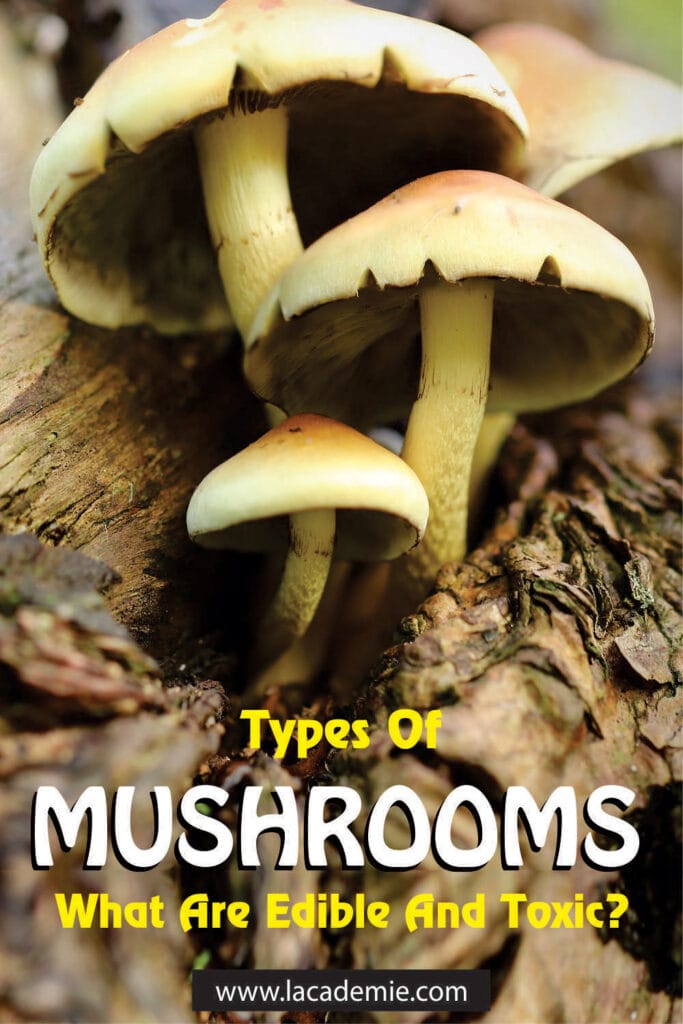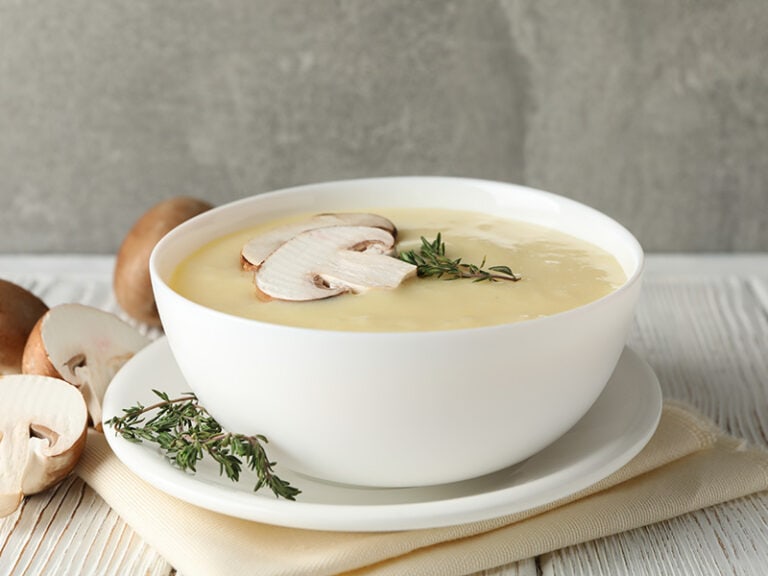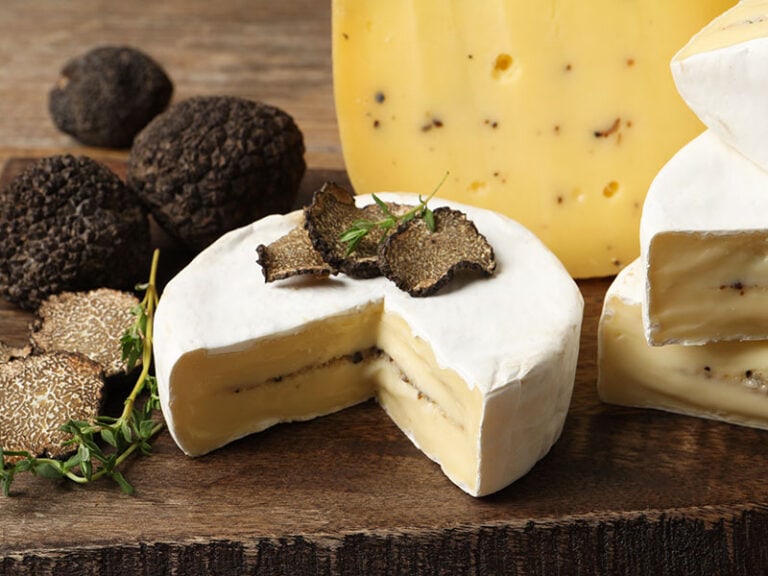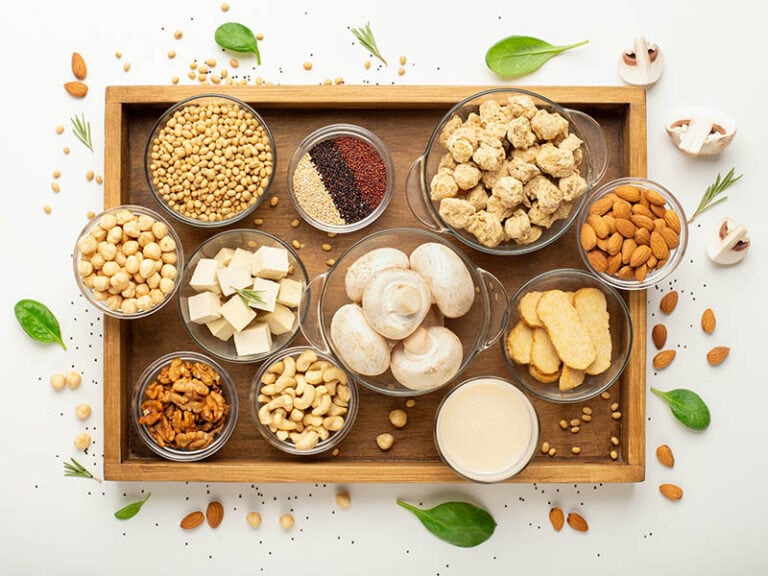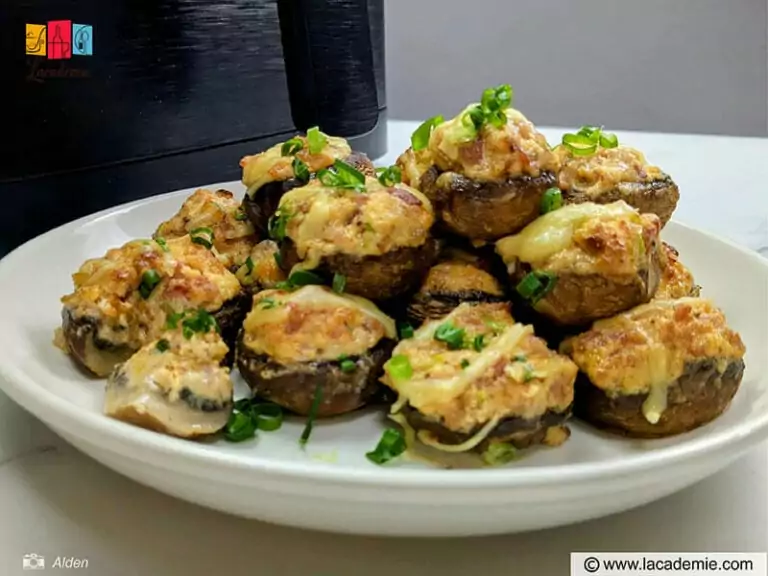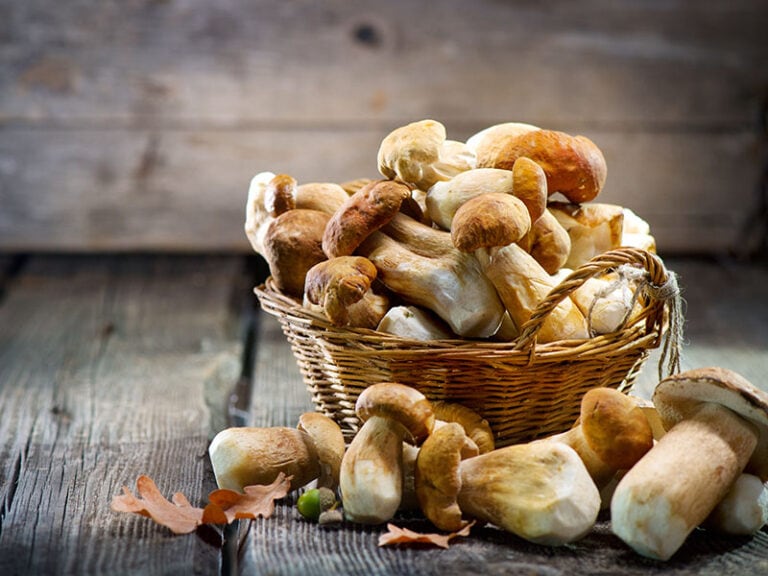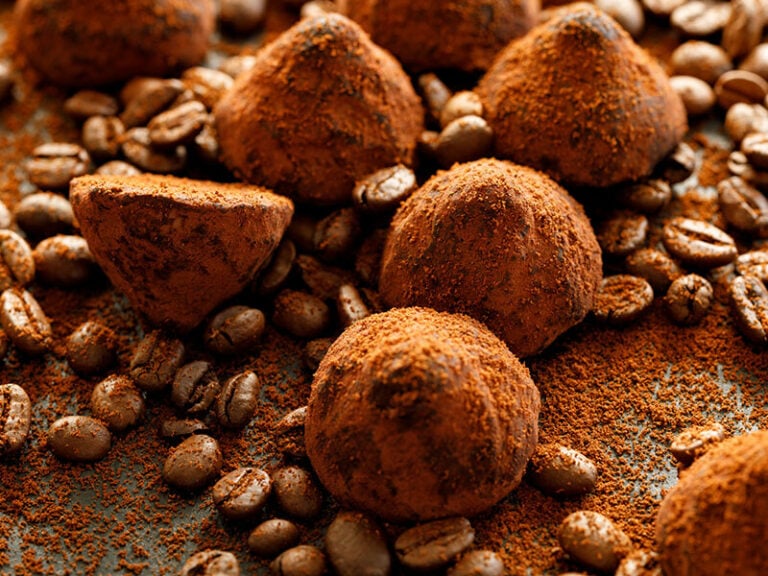There are more than 10,000 types of mushrooms over the world, but not all of them are safe to eat. Some mushrooms are toxic that can lead to serious problems, even fatal. Therefore, learning what species are edible and what are not is essential.
However, discussing all varieties in one article is impossible, as these foods’ beginning letters in their name can cover an alphabet board.
So I will only cover the 45 most common species in 2 main groups: edible and inedible (or poisonous). They all have different features and characteristics that you will be surprised by.
Let’s start with the overview of mushrooms to know what they are exactly and how humans use them.
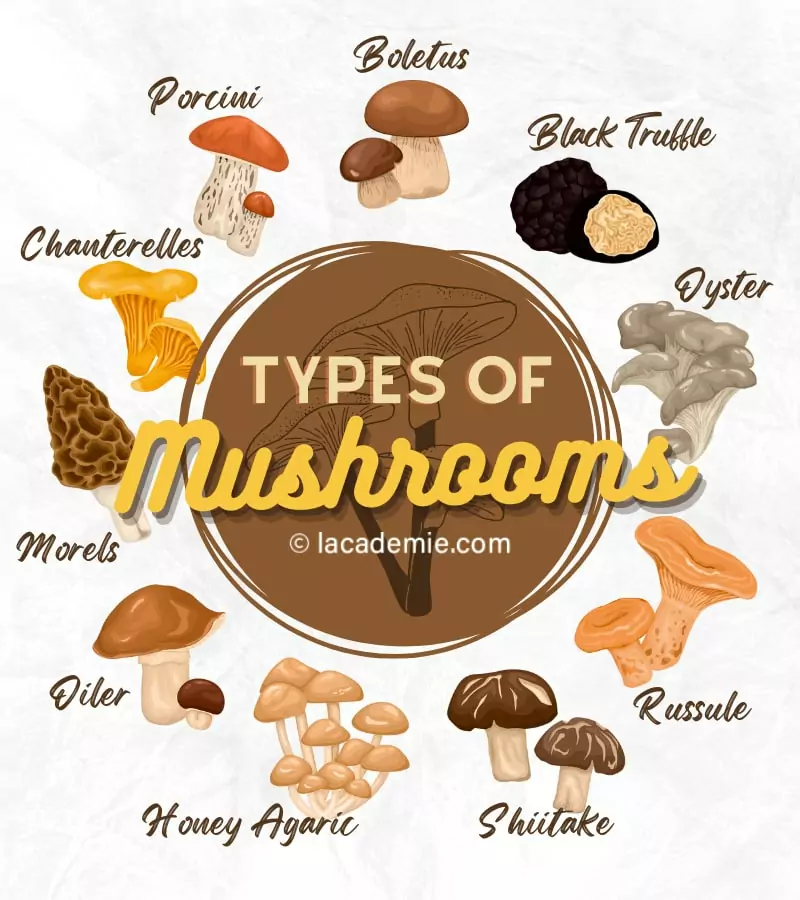
Get A Grasp On Mushroom – The Mystery Fungi
A mushroom is a fruiting body of the fungus that you can spot on soil, ground, or other food sources. They are neither plants nor animals, which come in many species with various traits. As explained above, mushrooms can be edible or toxic, which is the main topic of today.
Regarding edible mushrooms, the practice of using animal-derived products to produce commercial species raises a concern about whether mushrooms are vegan. In fact, most of them are ideal for veganism, but some might not (especially commercial ones).
Many edible mushrooms are good sources of vitamins and other nutrients to nourish your body. That’s why many vegans consider them a perfect meat alternative. Plus, you should know the differences between fresh and dried mushrooms to choose the right ones for your diet.
In contrast, you should avoid consuming wild mushrooms if you are unsure which species they are. Though the number of deadly mushrooms is not too high, some can lead to serious symptoms.
Besides their culinary uses, some species are perfect sources for making folk medicine, dyeing fibers or wool, fire starters (e.g., tinder fungi), or cleaning contaminated water as mushrooms can decrease bacteria levels.
Alright! Let’s move to the most important part about 27 mushroom varieties that can be amazing additions to your diets and 18 inedible species that you should avoid.
27 Edible Mushroom Varieties For Culinary Purpose
There are several mushrooms that you can safely consume. Many varieties, in fact, are protein-dense, making them perfect food sources to improve your daily dishes.
The flavor of mushrooms is also diverse based on their types, and their appearance can be even more so. Do you want to know more details? Here are 27 mushroom types in 3 categories: farm-grown, wild-harvested, and other edible wild mushrooms.
Farm-Grown Mushroom For Commercial Purpose
Below are 11 mushroom types that have been cultivated widely. Let’s see how wonderful they are in appearance, flavor, or application.
1. Button Mushroom (Agaricus Bisporus)
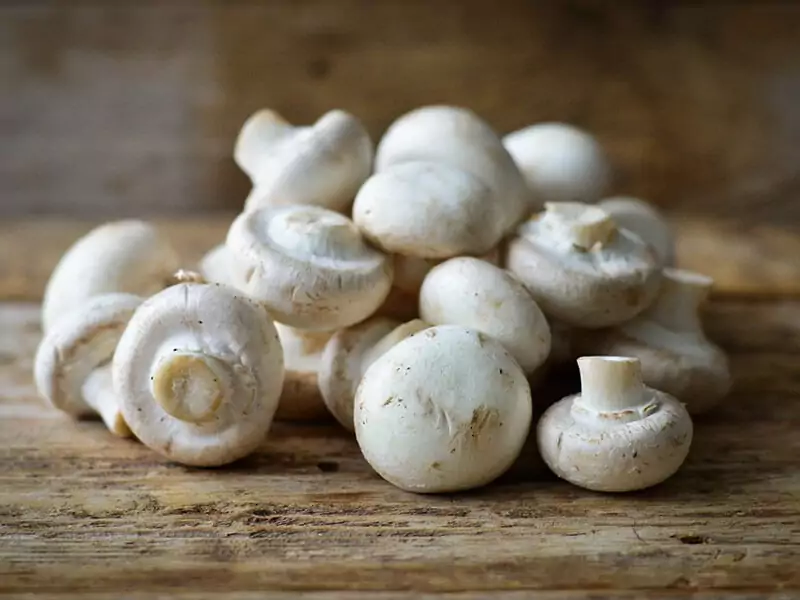
Speaking of the most recognized mushroom, it must be the button variety as you can spot them in many supermarkets. The other names of this type are white mushrooms or baby mushrooms.
They are white or brown mushrooms with cute shapes, including a smooth white cap and short thick stalk. However, brown button mushrooms might be marketed as chestnut mushrooms.
Normally, people will harvest them when they are immature. If they grow to a larger size, you might find them under another name – portobello mushroom, with a richer taste and meaty texture.
These foods have a mild, earthy flavor and chewy yet tender texture when cooked. And they can go well in a wide array of dishes, such as stew, fried, salads, pizza, sauces, etc.
As one of the most widespread mushrooms, Button fungi play a big role in the culinary world.
2. Bamboo Mushroom (Phallus Indusiatus)
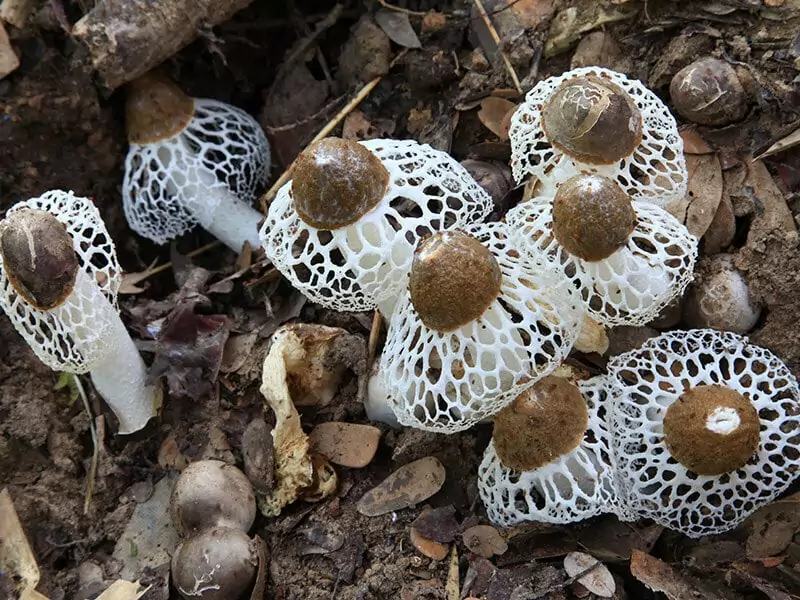
This is a special type of mushroom that can develop well in rich-soil gardens or woodlands, especially in tropical regions like southern Asia, or Americas, Africa, and Australia.
The appearance of this one is so special that you can remember it right from the first look. It has a bell-shaped cap with a white bridal veil that looks like a long lacy skirt underneath the cap. Thus, another name for this mushroom is “veil lady mushroom”.
Besides its cute look, you will love its earthy, rich yet delicate flavor with a soft texture. In China, it plays a major role in Chinese haute cuisine; you can usually find this type of mushroom in chicken soups or stir-fried dishes.
This fungus is available in both fresh and dried forms. They are a rich source of fiber, carbs, protein, bioactive, and antioxidant compounds.
3. Lion’s Mane (Hericium Erinaceus)
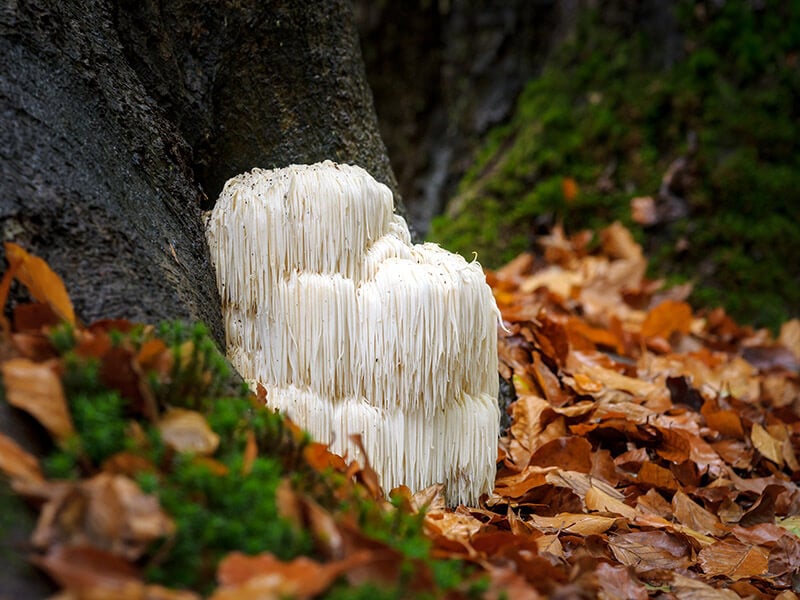
This fungus comes in large sizes with white color. They look like a hair lump that is pretty shaggy and similar to a lion’s mane, hence the name. Therefore, this is also one of the most distinguished mushrooms compared to others.
When it comes to this variety, the lion’s mane is famous for its medicinal purposes, particularly in East Asia, such as Japan, India, China, and Korea. This mushroom can protect you from dementia, anxiety, digestion, and cardiovascular diseases.
If you wonder if it is safe to eat raw mushrooms, in this case, you can enjoy lion’s mane raw. However, it is still best to consume them cooked. The texture and flavor of cooked ones is quite similar to crab or lobster, which is spongy, meaty, and slightly chewy with a sweet-and-savory taste.
You can also find these fungi in dried form so you can enjoy them with tea as it can act as health supplements and boost your immune system.
4. Burgundy Mushroom (Stropharia Rugosoannulata)
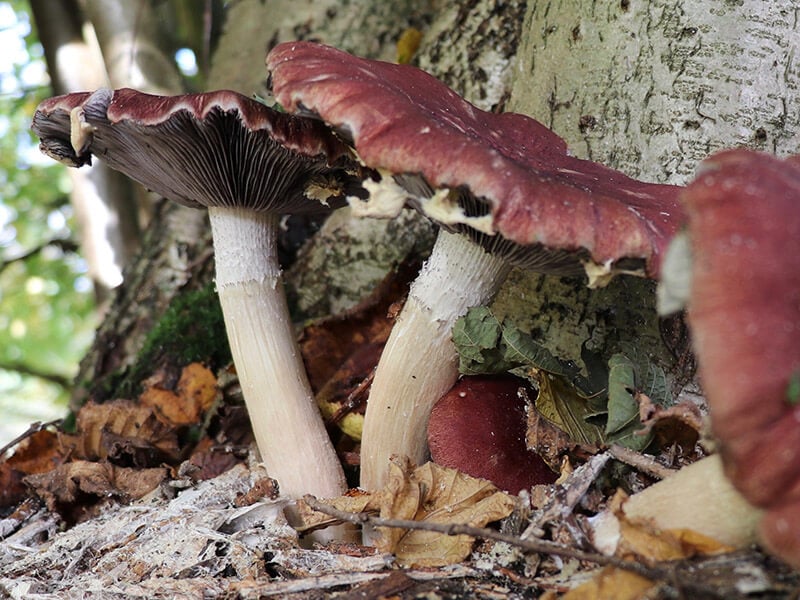
Burgundy (wine caps) is a familiar mushroom in Europe and North America (especially in fall and summer). It comes in with a dark reddish-brown cap and a tall white stem with a firm texture.
Indeed, these mushrooms taste delicious even when you consume them on their own or when you pair them with other dishes, for instance, steak or sauces. Many chefs recommend grilling or sauteing the mushroom for the best results.
Burgundy mushrooms belong to the genus Stropharia. But while many species of this genus are indelible and even classified as “hallucinogenic plants”, this beautiful type of mushroom is a delicacy no foodies can resist.
5. Wood Ear (Auricularia Auricula-Judae)
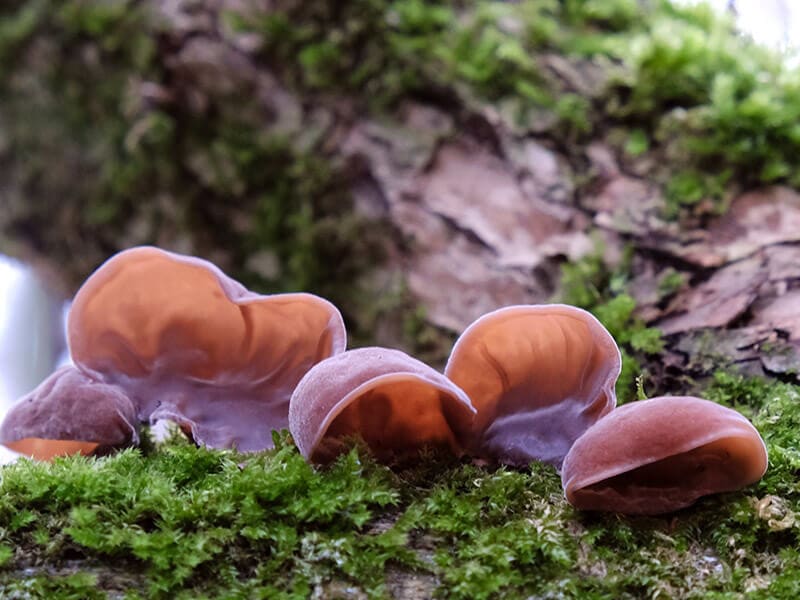
Wood ear mushrooms (tree jellyfish or wood jellyfish) are easy to find on the elder trees’ bark and mostly have a brown color (ranging from light to dark shade). These mushrooms resemble a small crinkled ear; that’s why they have this name.
Wood ear is a famous ingredient in many Chinese dishes, thanks to its crunchy texture and woody/grassy scent. Once cooked, the strong fragrance will reduce so you can add them to various dishes. Moreover, it can absorb other flavors well when cooking.
In Asian-style markets, they typically come in dried and shredded form. Popular Chinese dishes that use this ingredient are stir-fried dishes and hot and sour soups.
Nowadays, people in other countries like Euro, Australia, and Africa also cultivate this fungus to expand their menu.
If you do not know the best ways to prepare dried wood ear mushrooms, check this brief instruction for more details.
6. Oyster Mushroom (Pleurotus Ostreatus)
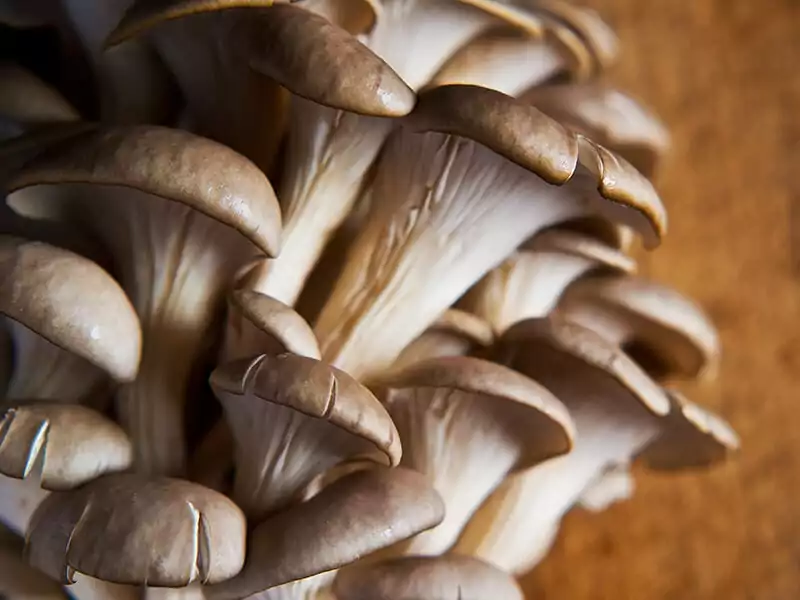
If you prefer a mushroom variety that you can easily grow at home to enjoy all year ground, oyster mushrooms are the best candidate. They can grow well on decaying rot or woody trees.
And as they are so easy to grow, these fungi are affordable. It has an oyster-shaped cap in a grayish-brown hue with a mildly sweet flavor. Do not worry; it does not taste like oysters at all but still has a subtle seafood hint in every bite.
Some people also claim this variety has a light touch of anise, making them a great ingredient in many cooking recipes like soups, salad, or stir-fry. Raw oyster mushrooms are quite firm and chewy, but they will have a chicken-like texture after being cooked.
Next to their versatile cooking applications, these fungi are rich in vitamin B, fiber, and protein. Cost-efficient, tasty, and good for health, it is such a fantastic mushroom to consume.
7. Straw Mushroom (Volvariella Volvacea)
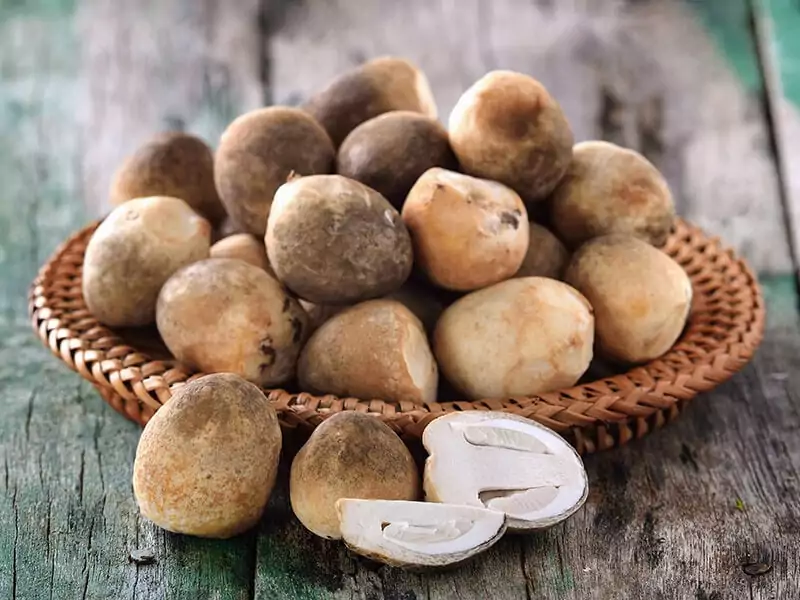
Boasting a smooth and silky surface with a mild and musky flavor, the straw mushroom is another edible type to enrich your meals.
They can have a white or brown color, and people normally collect them before their caps can cover their confining veils. Plus, it might look similar to small quail eggs, which are round and cute.
Straw mushrooms are a widely-used type in Southeast and East Asian countries. They are primarily sold in fresh form, but you can also spot them in canned or dried form in some areas.
Similar to most edible varieties here, straw mushrooms are nutrition-dense with high amounts of minerals, vitamins, and dietary fiber.
8. Beech Mushroom (Hypsizygus Tessulatus)
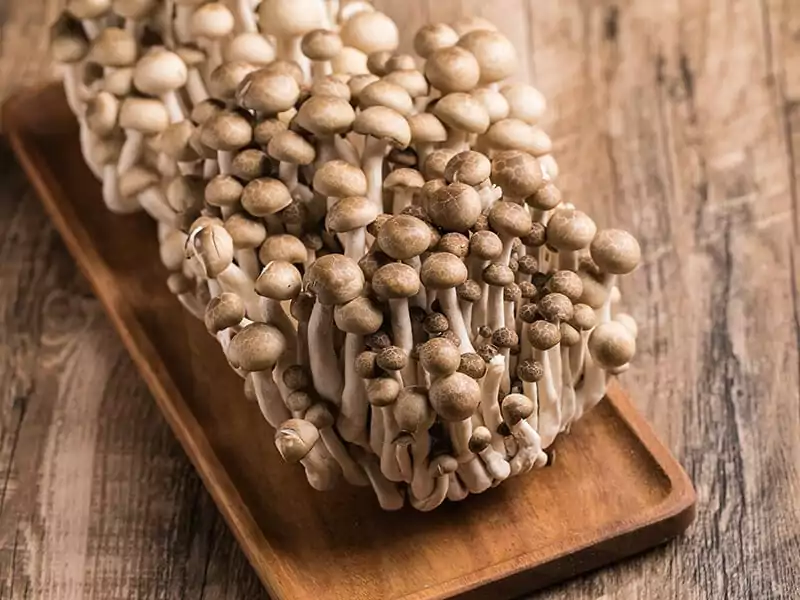
If you look for a nutty and savory-tasting mushroom with a crunchy texture, beech mushrooms can satisfy your taste buds.
The mushroom comes in clusters, and the whole body is edible (but you should cut off the base before consuming it). In addition, there are 2 main species in the same family, including white beech and brown beech mushrooms.
Beech mushrooms are usually available fresh and sold in markets. Their name comes from the fact they mostly grow on beech trees native to Europe, Asia, and North America.
For culinary purposes, they are best enjoyed when cooked because raw ones are very tough with a bitter flavor. You can use them to prepare your stir-fried dishes, stews, or soups. If you prefer to consume them on their own, sauteing is the best way to prepare beech mushrooms.
9. White Jelly/Snow Fungus (Tremella Fuciformis)
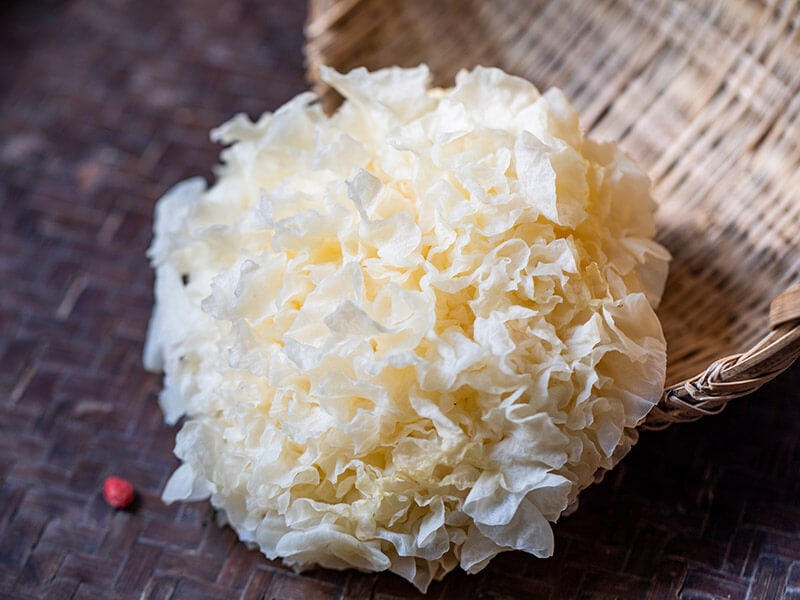
This uniquely beautiful fungus has a significant role in Chinese cuisine and medicine. As the name suggests, white jelly fungus owns a white to pale yellow hue and is relatively translucent. It has a jelly-like texture as well.
They can thrive well on broad-leaved trees in Asian countries. They are also ideal to grow in other tropics and temperate regions like New Zealand, Australia, and South and Central America.
In China, they regularly appear in sweet dishes, like dessert soup. Their flavor is pretty bland (or tasteless) with a gelatinous texture, making it go well with other ingredients. Many Chinese also believe this fungus is a good ingredient to promote longevity and health.
Furthermore, people also use them to make cosmetic products as the fungus can boost the moisture of your skin and prevent wrinkles.
After watching this video, you will finally understand why this mushroom is so well-loved in China.
10. Black Poplar (Agrocybe Aegerita)
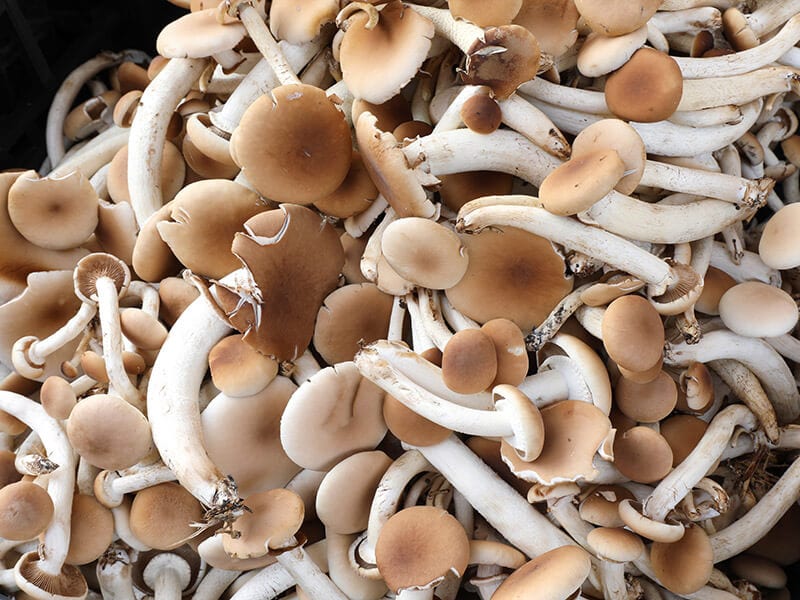
Black poplar mushroom (Pioounno in Italian) features a crunchy texture and mellow nutty flavor. They grow in dense clusters with golden brown caps and long white stems.
While this variety is native to Southeastern America and Europe, you can easily cultivate it in Australia, Asia, or other places. And they can combine excellently in your meat-based, paste, or risotto dishes.
On the other hand, the medicinal benefits of black poplar are noteworthy as it contains a high level of vitamin B5, copper, selenium, and various minerals. Therefore, many people believe these fungi can be a good food source to improve their immunity.
11. Enoki Mushroom (Flammulina Velutipes)
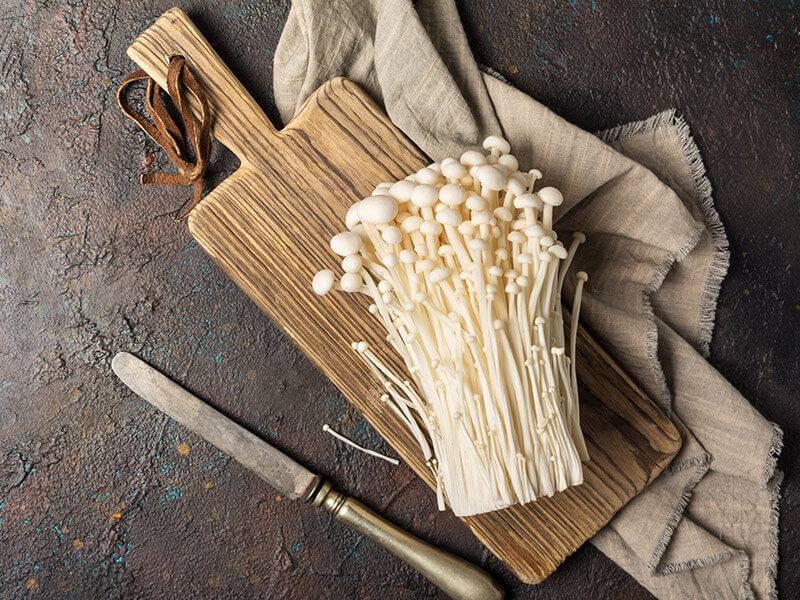
Enoki mushroom is inherently famous in Asian countries (like Japan, China, Korea, etc.), but it has gained popularity in Western areas recently.
They come in a big bunch with many long-stem thin mushrooms that connect to the end of a cluster. These tiny mushrooms come in white color with small caps. However, wild-grown ones might look a bit darker in color and shorter in size.
Enoki mushrooms are firm and slightly crispy. Their flavor is subtly sweet that can be a perfect addition to your soups or noodle dishes.
Wild-Harvested Mushroom That You Can Also Find On Markets
Several edible varieties grow well in the natural environment. Therefore, some might be rare and expensive. So if you want to store them for longer shelf lives and do not know whether to freeze mushrooms, you should know some tricks to do it properly.
And with the 11 following mushrooms, I hope you have a closer view of their uses and characteristics.
12. Gypsy Mushroom (Cortinarius Caperatus)
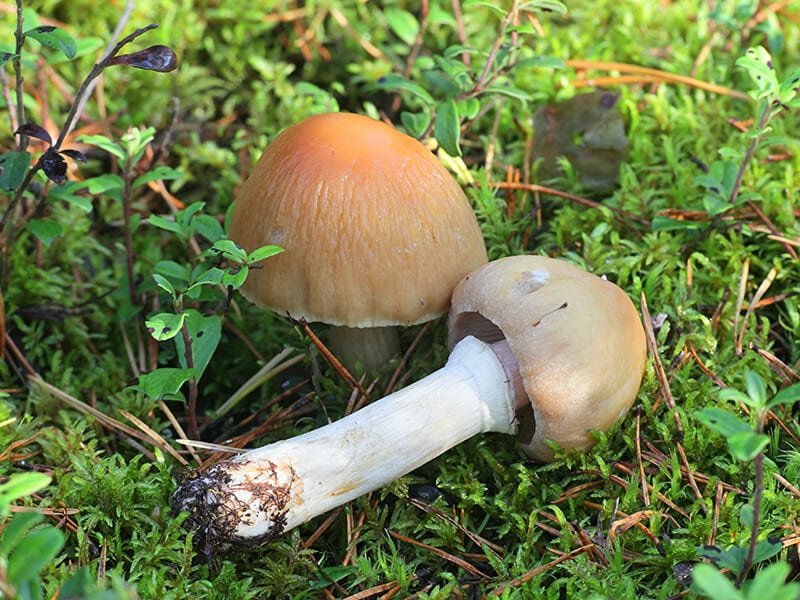
Gypsy mushroom has a yellow or ochre cap, pale clay-colored gills, and thick white stem. The dry cap can have more wrinkles when they fully expand. However, it is not a popular type that you can easily buy around the world.
In fact, they are occasional mushrooms that can be spotted in northern regions of Europe (like Scotland) and North America. For commercial purposes, Finland is the best place to buy this mushroom.
In terms of flavor, the body has a mild taste so you can mix it with other stronger-flavored mushrooms, namely milk-cap, chanterelles, etc. You can consume them raw if you prefer a slightly bitter taste. However, for the best result, it should be cooked to enjoy its nutty flavor.
13. Chinese Black Truffle (Tuber Indicum)
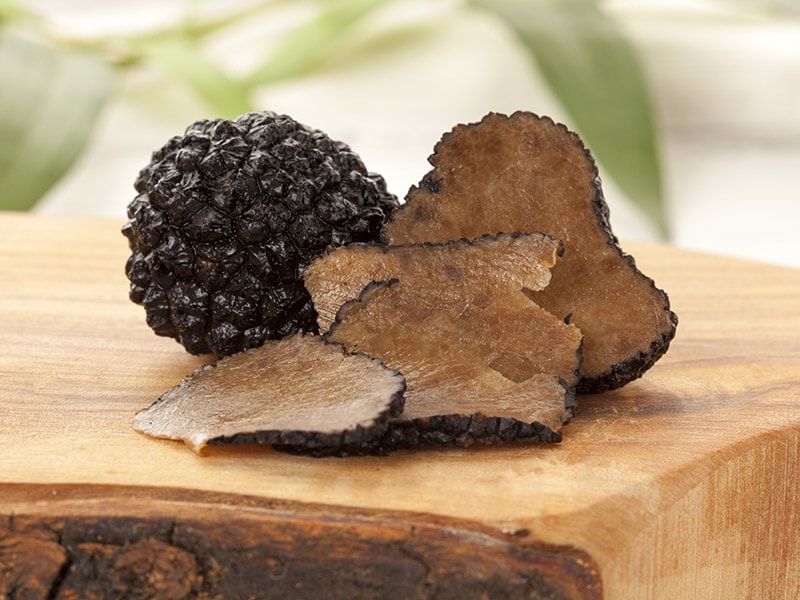
The Chinese black truffle is native to Eastern Asia. The scientific name of this species is Tuber Indicum, making it different from another variant named Tuber Melanosporum (also known as French black truffle).
If the French variety is one of the most expensive truffles in the world, this Chinese species is a better solution for your low budget. The flavor of this truffle is very mild with blacker color and less veining compared to other black truffles.
14. Matsutake (Tricholoma Matsutake)
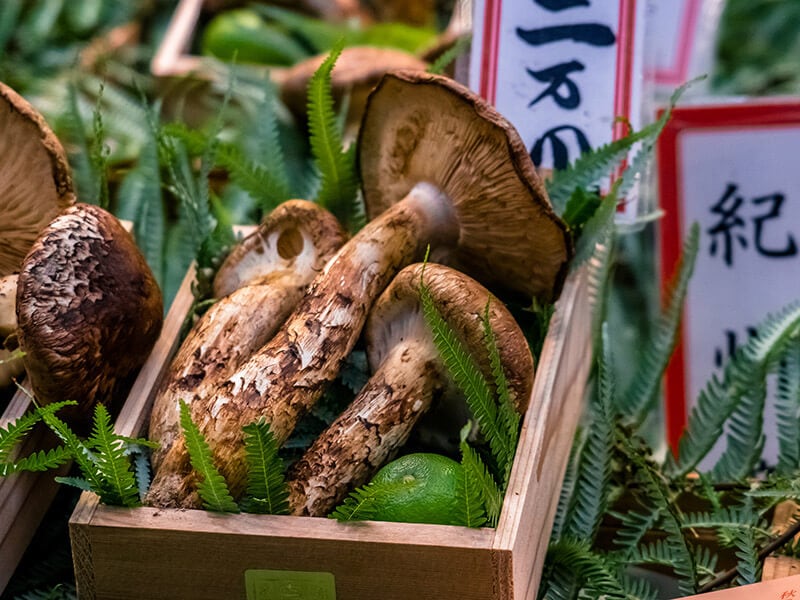
What makes matsutake mushrooms stand out from others is their distinguished spicy-aromatic smell and woody flavor. They are a wild species that you can easily find in Europe, East Asia, and North America, particularly from early fall to mid-winter.
At first look, it looks quite similar to many edible mushrooms with round brown caps, white gills, and white spore print. They grow under the trees, especially in red pine forests. That’s why they have the name “matsutake” (literally means “pine mushroom” in Japanese).
Unfortunately, among several Japanese mushroom varieties, matsutake is rare and not a commercially-cultivated species. The shortage in supply leads to the high price of the mushroom.
Want to know why Matsutake mushroom’s price is hefty? This video will tell you.
15. Hedgehog Mushroom (Hydnum Repandum)
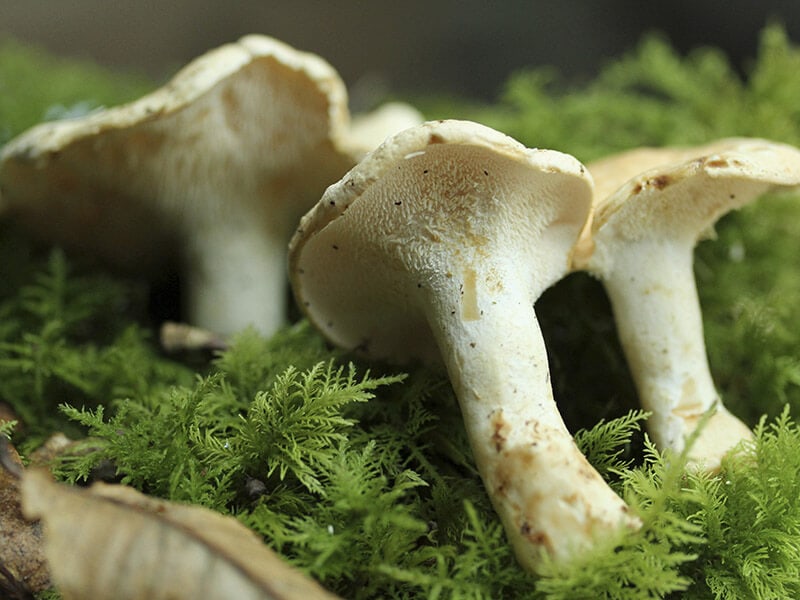
Hedgehog (sweet tooth) mushrooms grow in the wild with an irregular-sized, yellow (or orange) cap, and a thick white stem. This fungus has a pleasant smell with a nutty and sweet flavor; however, old mushrooms might be bitter.
Thanks to its delicious taste, it has become a good culinary ingredient in many countries. The ideal cooking ideas for hedgehog mushrooms are sauteed, simmered, and pickled dishes.
The fungus can thrive and start fruiting in summer and fall. For more information, hedgehog mushrooms are common in Europe and Canada, which you can easily come across in markets.
16. Porcini Mushrooms (Boletus Edulis)
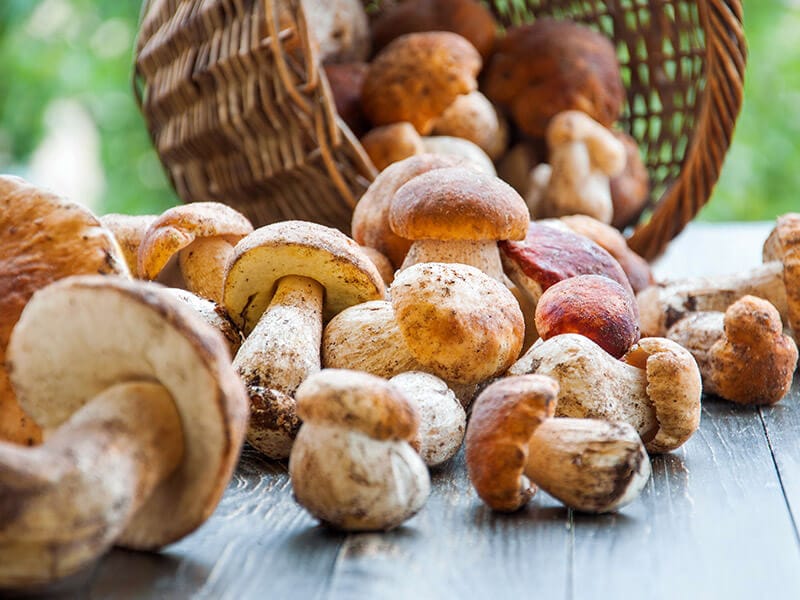
Porcini is widely found in the Northern Hemisphere in Asia, Europe, and North America. They can grow in tree plantations or forests (including coniferous and deciduous).
The fungus has a large brown cap with a convex shape. The size of their cap varies, which can reach 12 inches and around 6 pounds in weight. Their thick stem and stipe are white (or yellow) in color. When touching them, you can feel the mushroom is slightly sticky.
For culinary uses, they can be seen as one of the safest wild mushrooms to consume. The appearance of Porcini in Italian and French cuisine is certainly huge. Many chefs choose them to make their pasta, risottos, or sauteed dishes more delicious.
Speaking of their flavor, Porcini features a meaty and nutty taste with a creamy texture and an aroma similar to sourdough. They are available in both raw and dried forms. You can use dried mushrooms to enhance the flavor of your stews or soup.
17. Shiitake Mushroom (Lentinula Edodes)
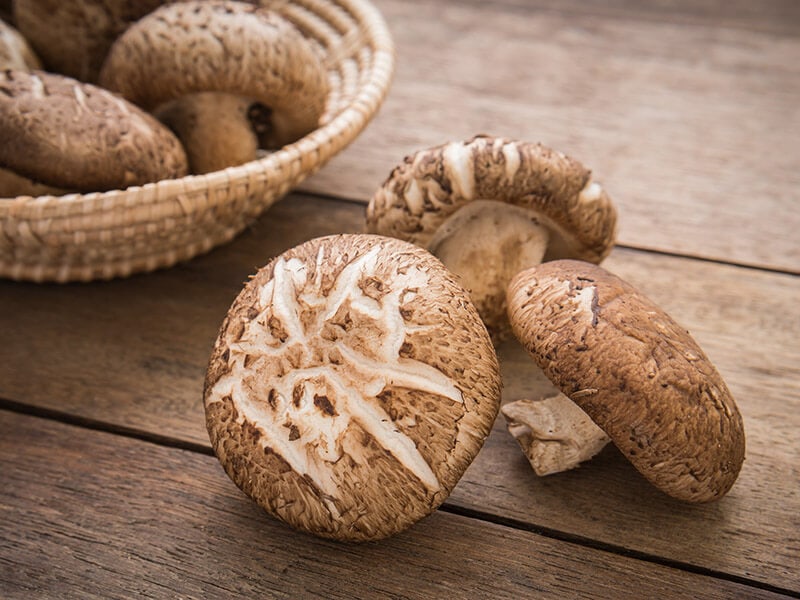
Shiitake mushroom originates from East Asia and has been an important food item in Chinese, Thai, and Vietnamese delicacies. Nowadays, you can also see them on Western dining tables thanks to their rich umami and savory taste with velvet texture.
They are also quite simple to recognize, with convex brown caps (from 2 to 4 inches), tan stems, and white gills. Though their texture is meaty and velvet, the stem is a bit chewy (or tough).
People usually sell them dried at an affordable price. But either fresh or dried, Shiitake mushroom is surely a good addition to your soup or any simmered/steamed meals.
The nutrients in these fungi are excellent too, with high amounts of B vitamins, iron, selenium, and more, that can support your heart health and immunity system.
18. Prince Mushroom (Agaricus Augustus)
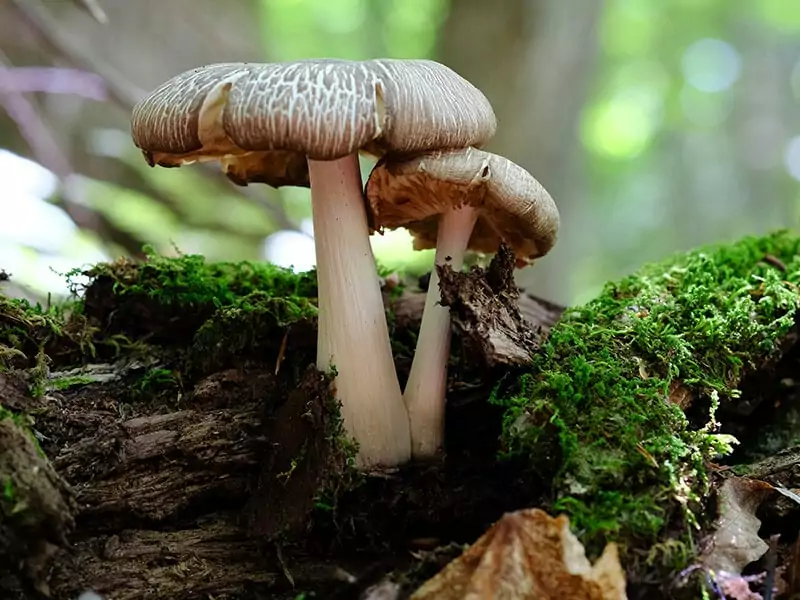
Prince mushroom impresses many foodies with its strong nutty odor resembling an almond extract. Additionally, the pattern on their cap is unique with several reddish-brown scales on a white background. Their stem is between 3 to 12-inch tall and does not attach to their white firm gills.
Many people claim they taste like button or portobello mushrooms. They are fairly soft and spongy with leathery stems. For safety, you should cook the mushroom before eating. Once cooked, they have a meaty texture.
Check here for more tips to identify the Prince mushroom.
19. Field Mushroom (Agaricus Campestris)
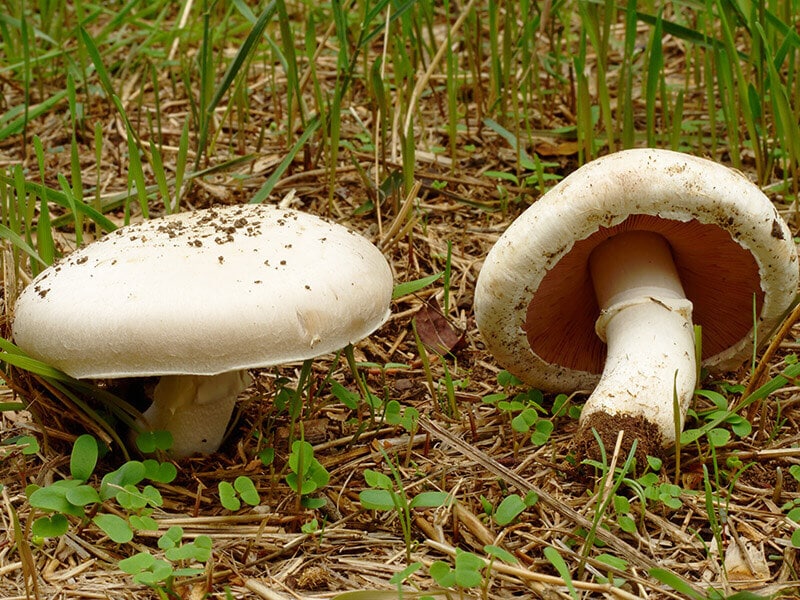
The field mushroom has a close relation to the button mushroom with similar creamy white color. However, their cap is pretty large (around 4-inch in diameter). The gills, initially, are pink and turn to dark brown as they mature.
Field mushroom’s white stem is from 1 1/8 to 3 7/8-inch tall. It is smooth and tapers at the base. When cut in half, you will see their white yet slightly pink flesh.
The flavor of these fungi is very subtle, even bland, so it would be better to cook them with other components or in sauces. In case you prefer their mild taste, adding raw ones to your salad is not a bad option.
Though they are edible species, field mushrooms are not a popular choice for commercial purposes because they mature rapidly and have a short shelf life.
20. Yellow Chanterelle (Cantharellus Cibarius)
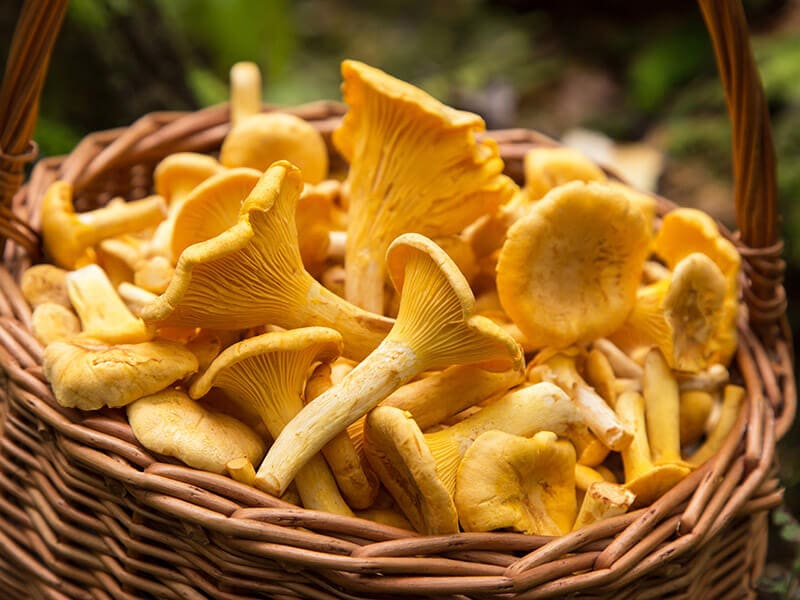
Let me introduce a beautiful mushroom named Yellow Chanterelle. With the golden yellow color, they are quite simple to identify. In fact, the color can range from light yellow to dark yellow. Their body’s width is from 1 to 4 inches and 2 to 4-inch tall.
Overall, they look like a vase with a hollow in the center. They grow in many places, especially in Europe, Mediterranean Basin, Or Scandinavia.
In terms of flavor, these fungi have a peppery and smoky taste when raw, but they can come out earthy and milder in flavor with a tender texture once cooked.
Speaking of their health benefits, Yellow Chanterelle is prized for its rich content of vitamin D to boost your bone health and immunity.
21. Maitake Mushroom (Grifola Frondosa)
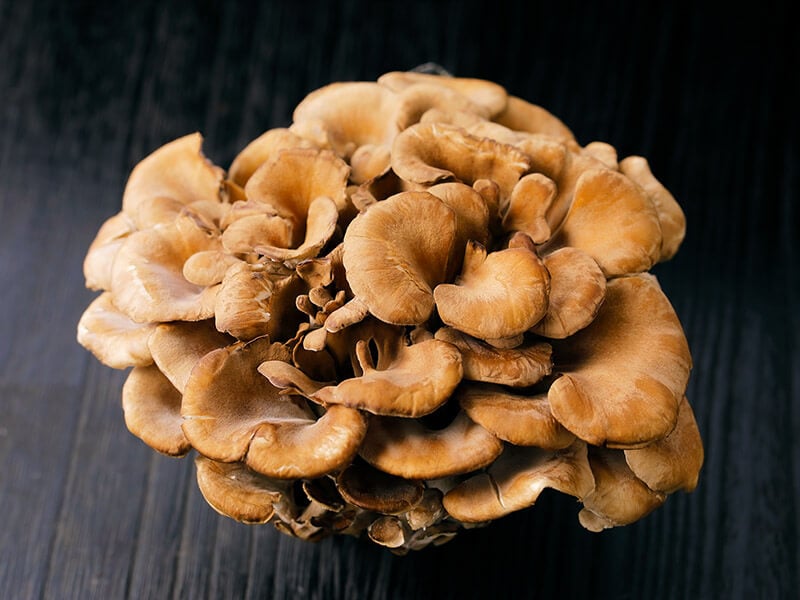
Maitake (sheep’s head) mushroom is another special fungus native to various places such as North America, China, and Europe. Their peak season is from late summer to early fall.
At first sight, these mushrooms are not attractive at all with many grayish-brown caps grown in clusters. These caps look curly and spoon-shaped. They can also turn to lighter tan brown when mature.
Maitake mushroom’s taste is earthy and peppery, making it a well-liked option for preparing various dishes like fried, stir-fried, soup, or used as a topping. In fact, this species is a significant cooking ingredient in Japan and China.
22. Saffron Milkcap (Lactarius Deliciosus)
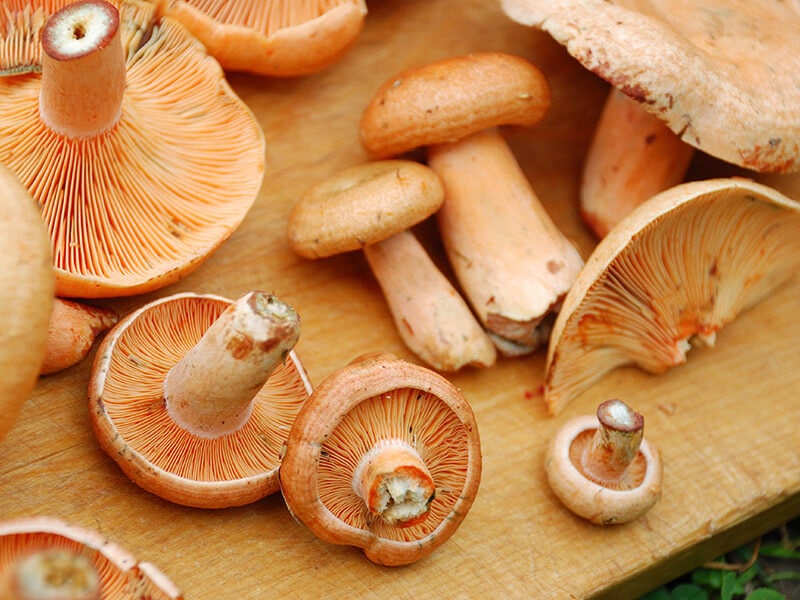
As the name suggests, Saffron Milkcap appears in a bright orange color like saffron. The cap has a convex or vase form that can reach 1.5 to 5.5 inches. Their stipe is in orange color too with 1 to 3-inch length.
If you want to find them in the wild environment, check under acidic soils or conifers in Europe or other places where people cultivate pine plantations.
Saffron Milkcap owns a characteristic bitter or mild taste. Therefore, they are ideal to go with butter, parsley, or other ingredients to enrich the overall flavor of your dish.
Their texture is faintly crispy, which makes them even more special compared to other types of mushrooms. So if you are looking for a mushroom to grill, Saffron Milk Cap is perfect.
How to cook wild Saffron Milkcap and enjoy them in the forest? This short video will amaze you.
Other Edible Wild Mushrooms
The world of mushroom varieties is abundant. And here are various wild mushrooms that you can safely enjoy. Let’s grasp some ideas about the following varieties.
23. Chicken Mushroom (Laetiporus Sulphureus)
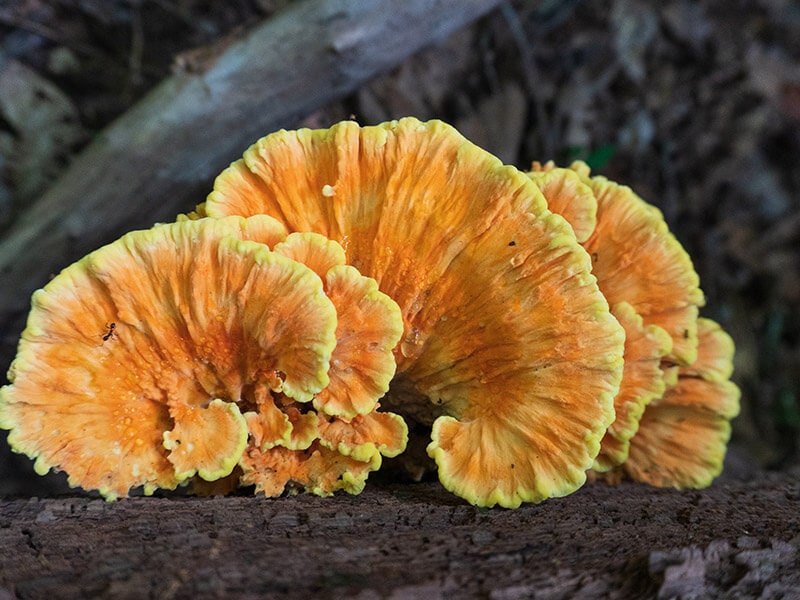
Do you know why they are called chicken mushrooms? Because their texture and flavor are very similar to chicken meat. So if you need something that works in place of the real chicken in your vegan or vegetarian dishes, this species is the ultimate choice.
However, some sensitive people might suffer minor symptoms like swollen lips after consuming chicken mushrooms. For more safety, you can start with a small amount of them and wait to see any reaction. If your stomach is still fine, then you are safe.
On the other hand, the fungus looks beautiful, with vibrant yellow to orange color. They grow in large brackets, some of which can weigh up to as many as 100 pounds. Their habitat is mostly on woody plants, like oak, eucalyptus, willow, and more.
24. Honey Mushroom (Armillaria Mellea)
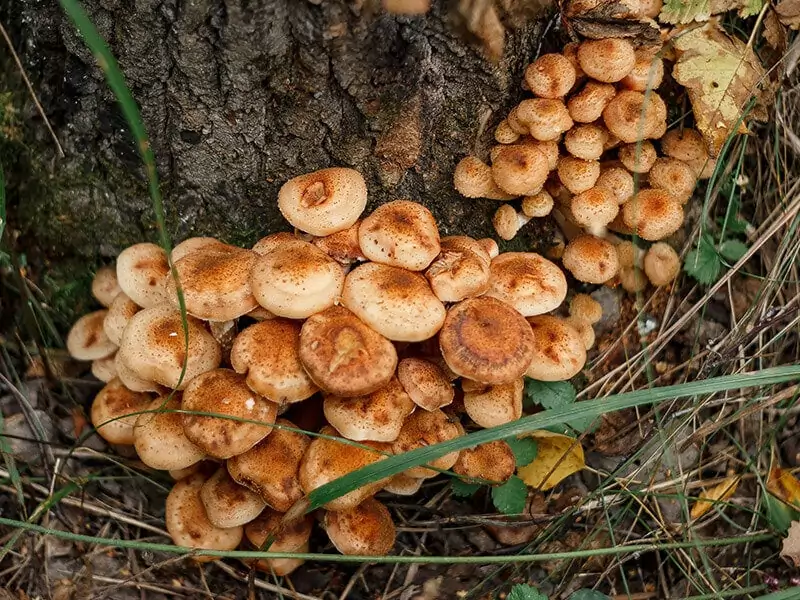
If you spot some mushrooms growing in a clump with a honey color, the high possibility is a Honey mushroom. If you are still not unsure how to identify them, check for their cap.
The Honey mushroom’s cap has some little iridescent hair on the center, and the cap itself is quite sticky. They also have rings on their stems. Moreover, their spore print is always white. This variety thrives on dead or dying hardwoods and is usually found in temperate areas.
For culinary uses, the best part to enjoy is the cap because its stem can become fibrous when aged. Of course, the younger the mushrooms are, the more tender they are. If you like a bit of crispiness, you can choose those with smaller caps.
What are the differences between Honey mushroom and Deadly Galerina?
25. Orange Milkcap (Lactarius Deterrimus)
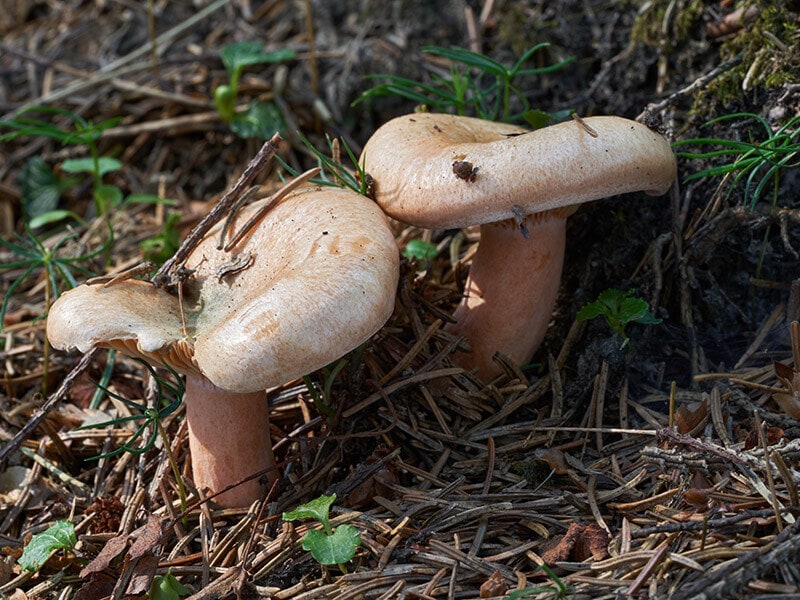
Another edible Milkcap that you can try is Orange Milkcap. Their distribution is mostly in Europe, but you are able to find them in some Asian countries like Pakistan, India, and Turkey.
This is a medium-sized fungus with a 4.5-inch cap. The primary color of them is brownish-orange with darker color toward the edges. The cap has a funnel shape that can be shiny if the mushrooms are dry or greasy when they are in a moist environment.
Generally, this is a good edible mushroom that fits well in many stir-fried dishes (with oil or butter). Their flavor is mild, with a few fruity hints. If you cook them in water, they can come out very soft. The young Orange Milkcap is also ideal for making dried or pickled food.
26. Cauliflower Mushroom (Sparassis Crispa)
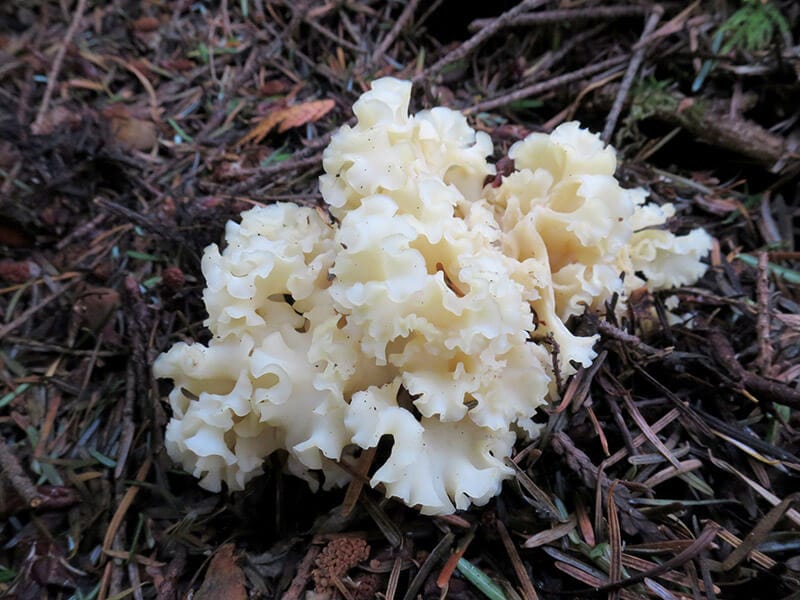
Cauliflower mushrooms have umami, earthy flavor, and their texture is unique. After cooking, they can maintain their chewy texture, similar to pasta noodle texture.
In addition, these fungi are special because they look like a head of cauliflower or a sea sponge. Their color varies, which can be yellow-gray, brown-yellow, or creamy white like cauliflower.
If you want to find them, search for them on the base of hardwoods, like conifers, oak, pine, or spruce. Currently, they are also a widely-cultivated species in Australia, the USA, Korea, and Japan.
27. Pinewood Mushroom (Agaricus Silvaticus)
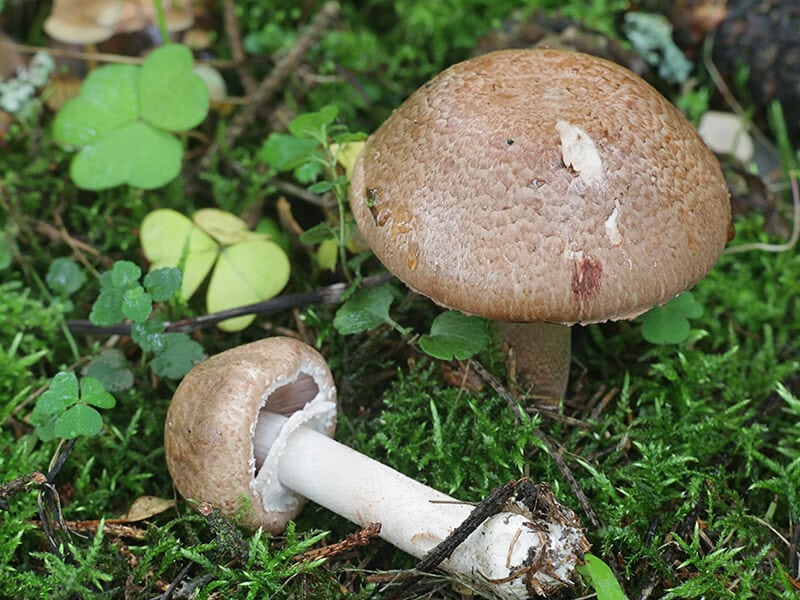
North America, North Africa, and Europe are the 3 main areas to find Pinewood mushroom (Scaly wood mushroom), particularly from early summer to early winter.
First recorded in the 1770s, they are edible species with a grayish-brown cap, brownish stem and gray gills when immature. Their flesh is reddish after being cut and has a subtle earthy flavor. Their firm texture is a big plus as well because they can hold up well after cooking.
18 Inedible Or Poisonous Mushrooms That You Should Be Aware
Next to edible mushrooms are poisonous ones. They can lead to some serious poisoning symptoms, even death. So how can I know what mushrooms I should avoid? Please do not skip this part to find out about species that contain various toxic substances.
In Europe
In this section, I will group these toxic mushrooms into 3 categories based on their geographic location. Let’s begin with those native to Europe or mostly found in this region.
28. Lilac Bonnet (Mycena Pura)
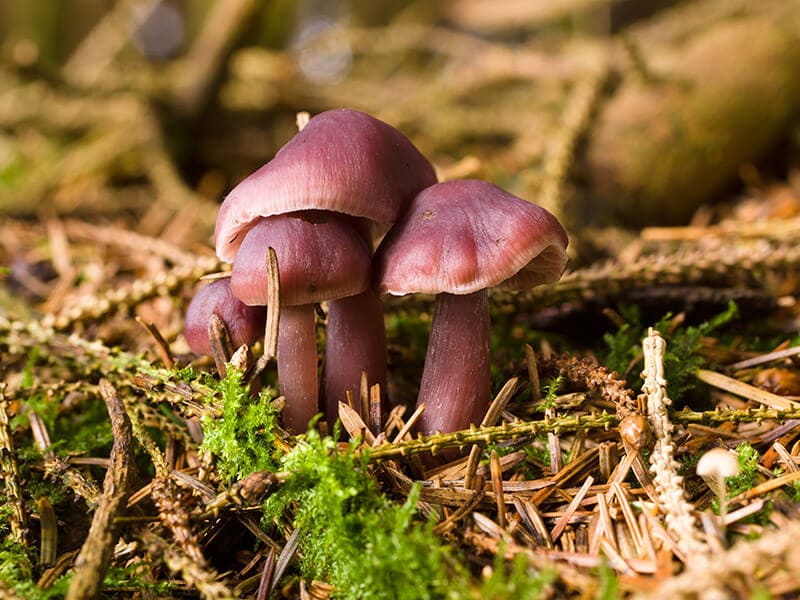
Lilac Bonnet is a beautiful mushroom with a pale purple cap (around 0.5 to 2 inches), white to pale pink stalk (0.8 to 2.8 inches in length) with white gills. In fact, you might find them in other colors, ranging from lilac to yellow or white.
Lilac bonnet mushrooms belong to the Mycenaceae family. People can spot them in many parts of mainland Europe, especially Ireland and Britain. And they have a very distinct radish odor.
They contain a small level of mycotoxin muscarine, which is a poisonous substance; therefore, eating it is not highly recommended.
29. Ivory Funnel (Clitocybe Dealbata)
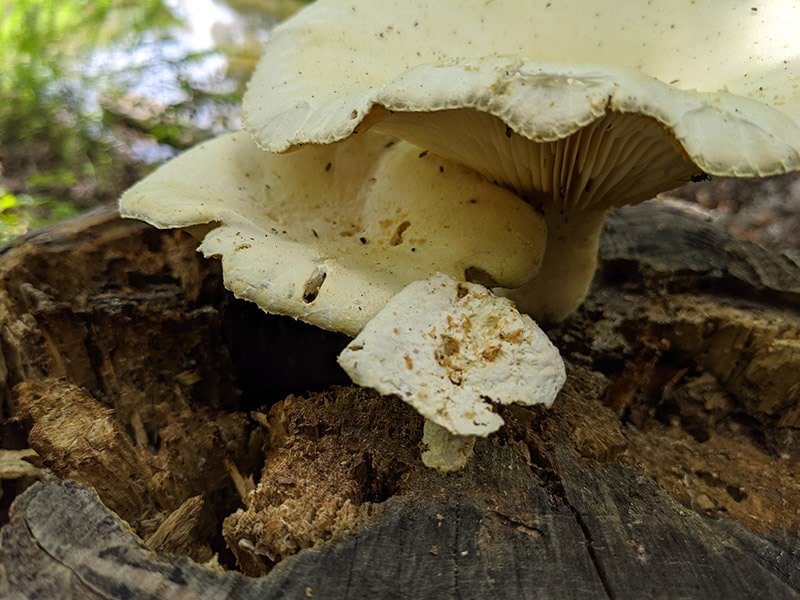
The first thing to remember is that Ivory funnel is a dangerous species that you must avoid at all costs. Similar to the above species, this mushroom is packed with muscarine that can cause many nerve poisoning, like sweating, tearflow, or worse, such as respiratory failure or arrhythmia.
They are small fungi with white funnel-shaped toadstools. The flattened cap can turn to pale brown (or gray) color when aged. Their gills are white and fairly broad. Plus, Ivory Funnel mushrooms have no distinct smell.
Their habitats are normally on fields, lawns, roadsides, or any grassy environment. They thrive in summer and fall.
30. Brawny Bolete (Imperator Torosus)
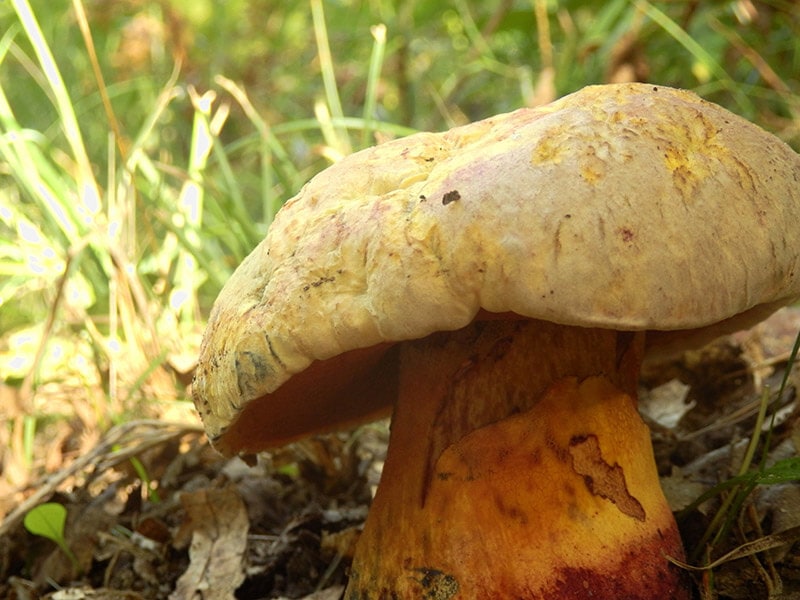
The Brawny Bolete mushroom originates from southern Europe, Israel, and the Caucasus. This fungus is pretty popular in summer and autumn on deciduous trees.
Brawny Bolete’s body is stocky with a thick stipe. The ochre-colored cap can reach 8 inches with yellow round pores, a red-to-brown stipe that ranges from 2.4 to 6 inches in length. Their flesh’s color varies based on the age of the mushroom.
Their surface’s texture is pretty velvety and can be smoother when aged. On the other hand, Brawny Boletes do not have a pleasant smell. Death is rare, but this one is not a 100% safe species to consume, even if they are cooked or raw.
31. Satan’s Bolete (Rubroboletus Satanas)
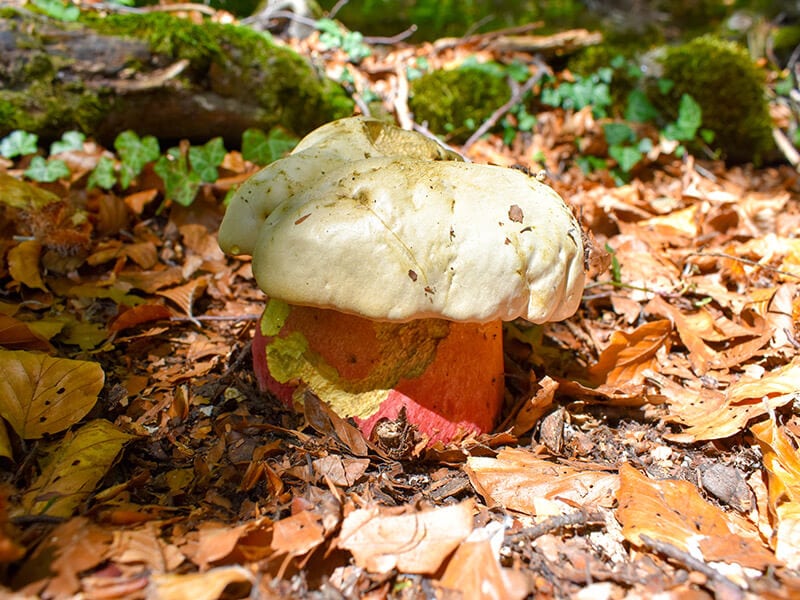
Another poisonous Bolete mushroom is Satan’s Bolete, especially when you consume them raw. The typical gastrointestinal symptoms you can face are abdominal pain, vomiting, nausea, or even bloody diarrhea (which can last 6 hours maximum).
Another name for Satan’s Bolete is Devil’s Bolete. They are a fungus in the Boleteceae family. Their habitat is in warm areas in Europe that can thrive in broad-leaved woodland.
The appearance of this fungus is easy to recognize with its bright-colored body and big cap. Their pores’ color ranges from yellow to reddish-orange. Plus, the smell is very unpleasant when overripe.
If you want to learn more about identifying Satan’s Bolete, this video will help you.
In North America
North America is another ideal place for several inedible fungi. Here are 5 varieties (from popular to uncommon ones) and ways to recognize them.
32. American Abrupt-Bulbed Lepidella (Amanita Abrupta)
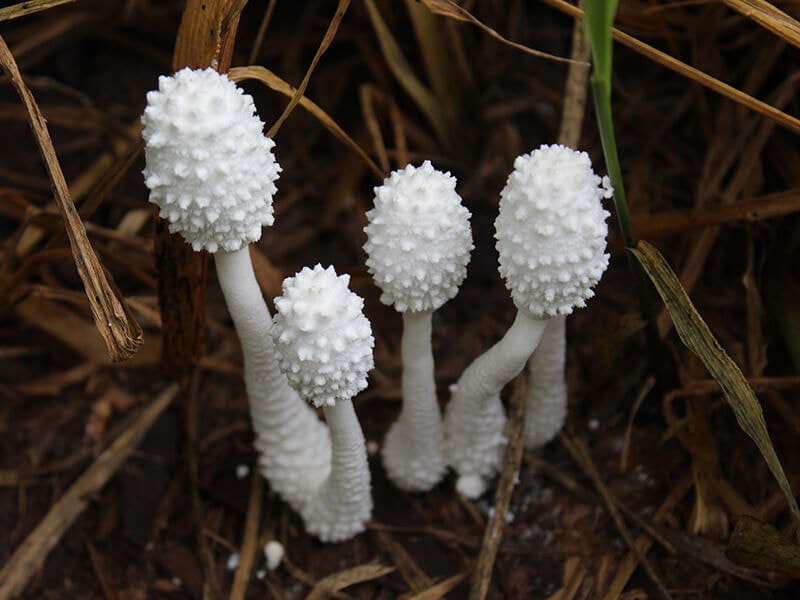
The easiest way to identify the American Abrupt-Bulbed Lepidella is its abrupt bulb on the base. Above the bulb is a 2.6 to 4.9-inch stem. Their convex cap is between 1.6 to 3.9 inches covered by several pyramidal-shaped warts on the surface.
The whole body of this fungus is white, and they have no distinct odor. As a matter of fact, the edibility of this mushroom is still in question; however, most people recommend staying away from them.
33. Eastern American Floury Amanita (Amanita Farinosa)
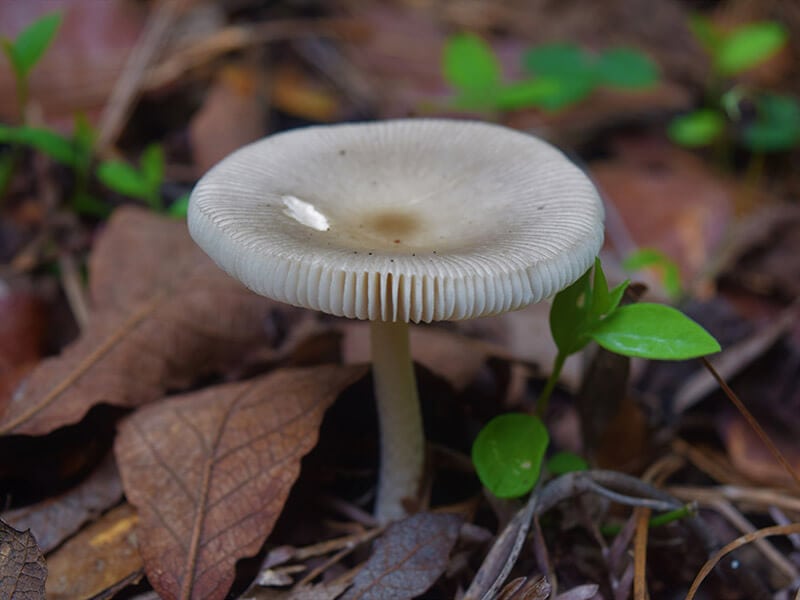
The most distinctive characteristic of Amanita Farinosa is the very fine powder covering its cap and stem. The powder can disappear when they mature.
So if you need another way to recognize them, check for their size. They are typically a small species with bulbous stem bases. In addition, this toxic fungus has no ring or volva.
The common places to find the mushroom are in beech, oak, or hickory forests. They are pretty popular across North America from late summer to late fall.
34. Hooded False Morel (Gyromitra Infula)
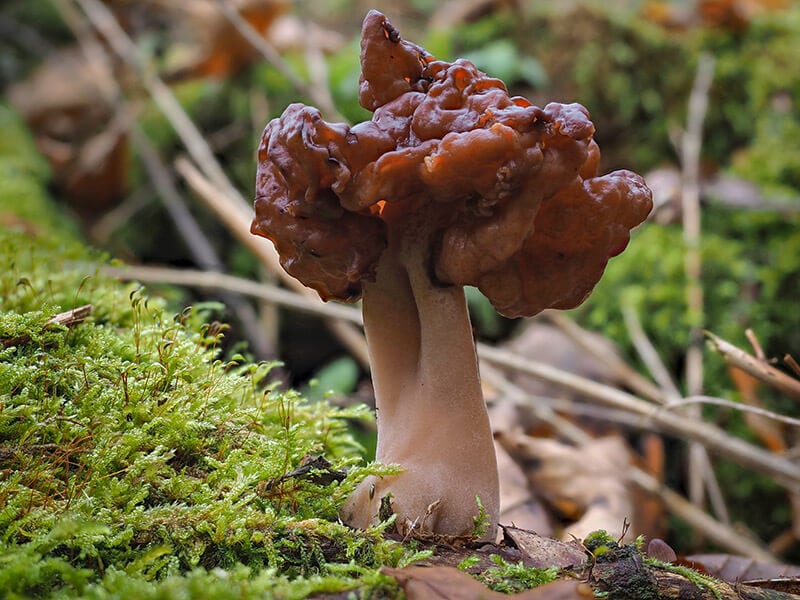
Hooded False More owns an odd and ugly appearance when mature. The fruit body has a saddle-formed shape in a reddish-brown hue. Their stipe ranges from 3/8 to 1-inch thickness with a lighter color (compared to the cap).
They grow significantly in woodland or on decayed wood. Besides North America, their distribution also extends to southern Mexico or north Canada. Some might be found in Asia, Europe, or even South America.
This is an inedible mushroom because of the gyromitrin compound in it, which can accumulate carcinogenic effects. Some people claim the compound can be eliminated if you parboil them in a lot of water. However, it is still not a safe-to-eat mushroom.
Here are some tips for identifying True Morel and False Morel mushrooms.
35. Boletus Pulcherrimus (Rubroboletus Pulcherrimus)
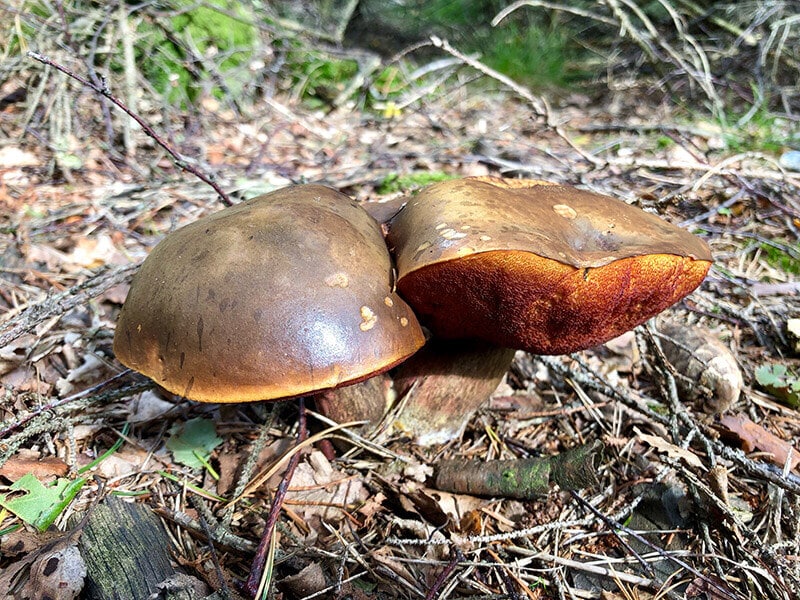
Belonging to the Boletaceae family, Boletus Pulcherrimus is a toxic mushroom featuring a red-to-brown convex cap and yellow flesh. The cap has a smooth surface when they are young. Their stem is relatively firm and can range from 3 to 8 inches.
They are widely distributed in western North America, and sometimes they might appear in Canada. The best weather for them to thrive is after the rainy season in the fall. So they start to fruit from late fall to winter.
As a poisonous species, Boletus Pulcherrimus can result in many gastrointestinal symptoms, even when consumed in a small amount. Also, they contain a low amount of muscarine that can damage your nervous system.
36. Turbinellus Kauffmanii
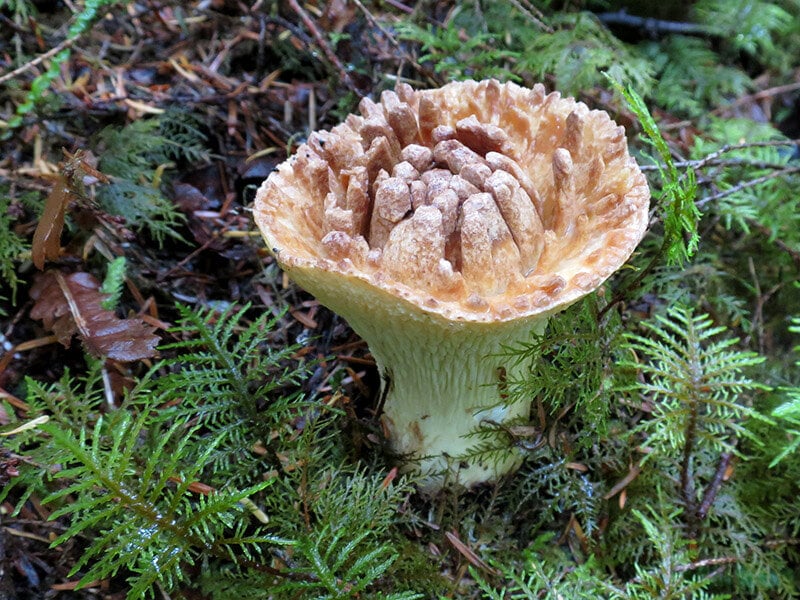
This mushroom is native to North America, particularly in northern California and the Pacific Northwest. Though there is no confirmation regarding the toxicity of Turbinellus Kauffmanii, the fungus is proven to contain a low concentration of norcaperatic acid.
According to some research, this substance can weaken a rat’s muscle and central nervous system. So generally, it is not a suitable mushroom to safely consume.
The good news is you can recognize them easily due to their unique appearance. Unlike other species, Turbinellus Kauffmanii’s whole body has a vase shape with thick white flesh. Their cap is around 4 to 8 inches in diameter with brown (or olive) color.
In Various Places
The last part will cover 9 fungus species that appear in various countries. Read on for more insights!
37. Jack-O’lantern Mushroom (Omphalotus Olearius)
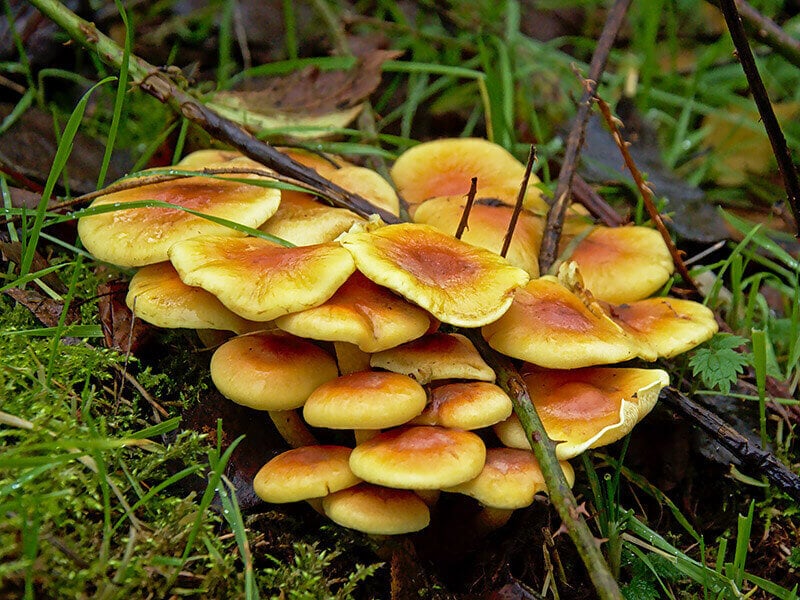
Jack-O’lantern contains a certain amount of toxic substances, but it can rarely kill an adult. However, the elderly or children should be more cautious as they can die if consuming a large amount of this mushroom.
The typical symptoms after eating this fungus are vomiting, dizziness, nausea, or stomach cramps. If these causes lead to dehydration, it can result in a more serious problem like organ failure.
So how to recognize these fungi? They look quite similar to Chanterelle mushrooms with dark yellow-orange color (like a pumpkin hue). The cap is from 2 to 8 inches with a bump in the center. Their stalk is around 2 to 8 inches long. In addition, it can glow in the dark.
Jack-O’lantern mushrooms are pretty but poisonous. So if you want to know more about them, you should not miss this instruction.
38. Deadly Dapperling (Lepiota Brunneoincarnata)
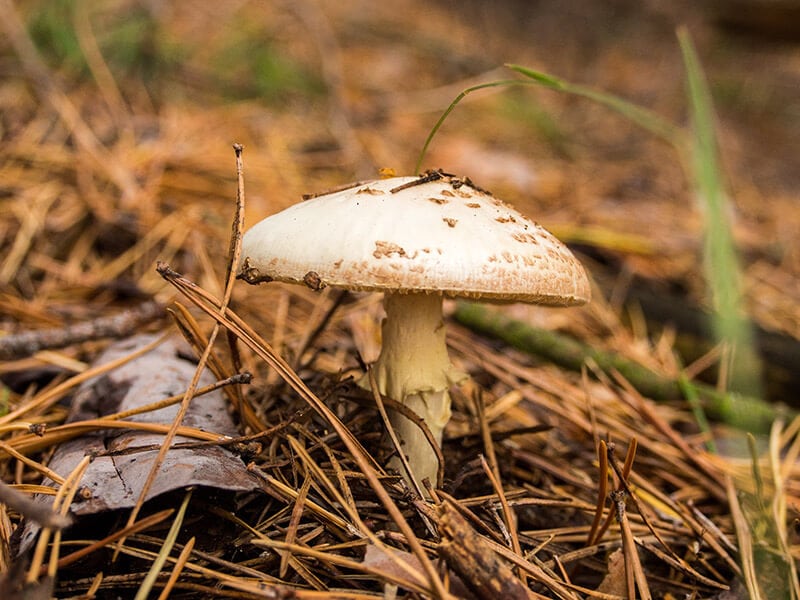
Another toxic mushroom that you can stay away from is Deadly Dapperling. As the name implies, it contains a significant amount of alpha-amanitin, which leads to fatal poisoning.
The earlier symptoms are similar to other food poisonings, such as vomiting and nausea. However, it might eventually damage the liver seriously after a few days.
The bad news is these mushrooms are not easy to recognize; therefore, many people might mistake them for edible ones. They are gilled species with scaled caps in brown color and brown stems. Deadly Dapperling’s odor resembles unripe fruit.
Regarding its distribution, these fungi are popular in warm regions of Europe. Researchers also find them in various Asian countries, like eastern China, Turkey, Pakistan, Iran, and Israel, as long as there are grassy areas.
39. Green-spored Parasol (Chlorophyllum Molybdites)
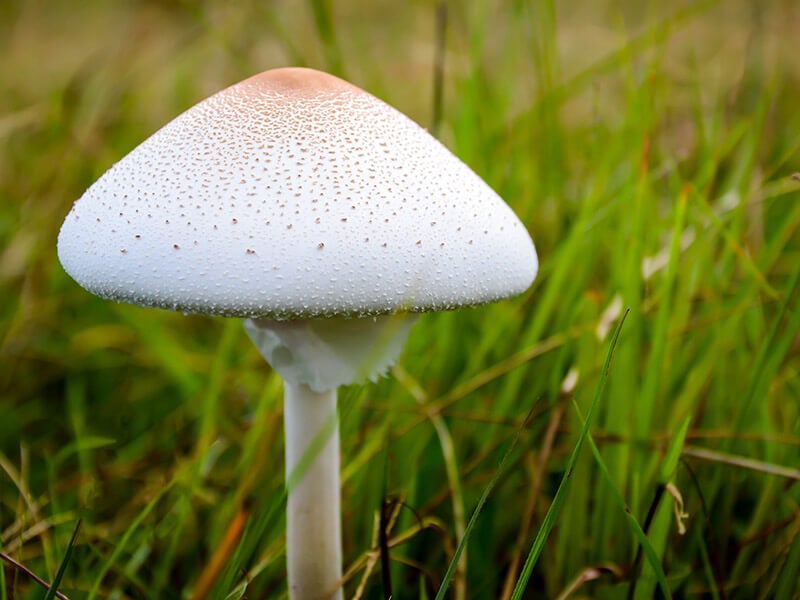
Green-spored Parasol (False Parasol) is a fungus in the Agaricaceae family that you might easily mistake with other edible mushrooms in the family (like True Parasol – Macrolepiota procera).
They are poisonous and very popular in the USA, particularly in California and eastern North America. Green-spored Parasol also appears in tropical or temperate countries, such as Australia, Cyprus, or Scotland.
Like most mushrooms here, this fungus includes a broad, flattened cap, tall stipe, and white gill (which can turn to a green or darker color when mature). Another key characteristic that distinguishes it from other species is its rare green spore print, hence the name.
If you accidentally eat it, you might suffer some severe ingested symptoms after 1 to 3 hours. But luckily, there have not been any death records regarding this issue.
40. False Death Cap (Amanita Citrina)
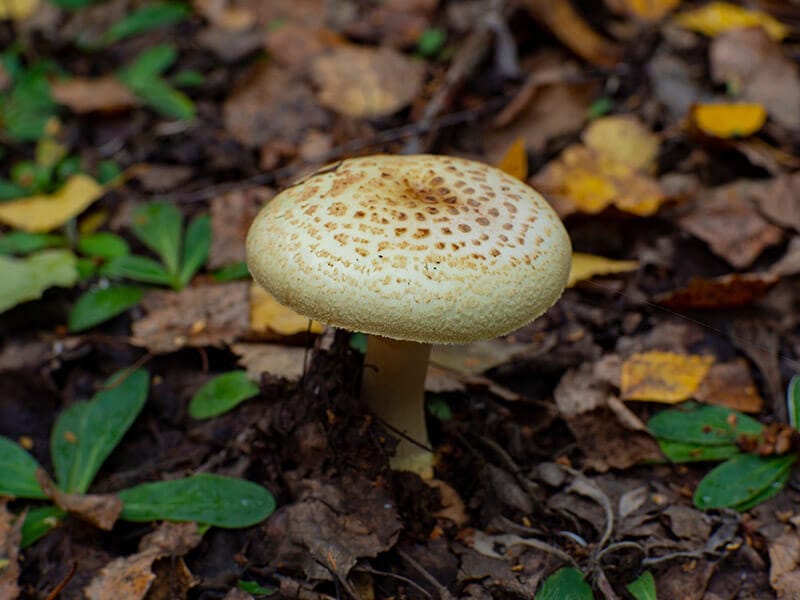
False Death Cap (Citron Amanita) is an inedible fungus that comes in a white (or pale yellow) cap with a white stem, vulval, and ring. Their habitat is mainly in mixed woodland (like coniferous and deciduous) and can be found in Europe (in fall) or North America (in oak/pine forest).
Though False Death Cap consumption is not known to cause deaths, the alpha-amanitin substances in these mushrooms still have negative effects on humans’ health if you eat them in large amounts, no matter whether they are consumed raw or cooked.
41. Destroying Angel (Amanita Bisporigera)
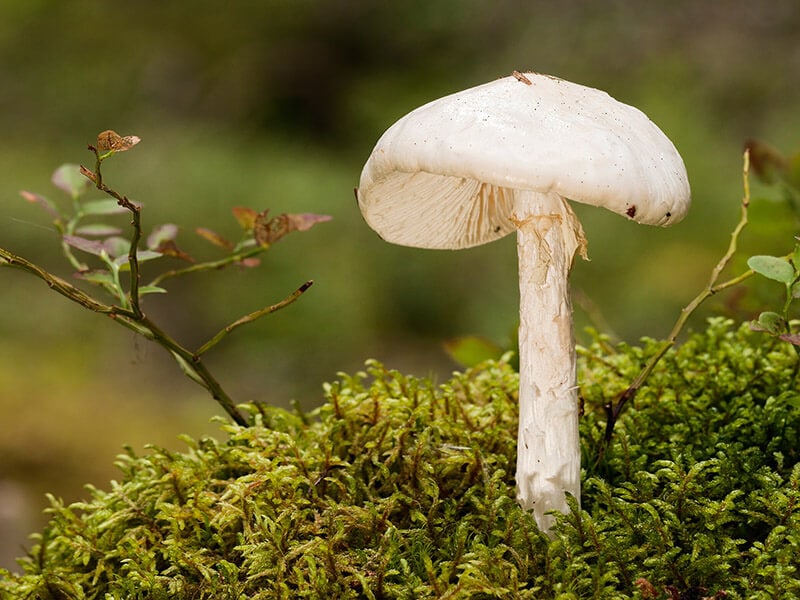
Destroying angel is one of the most deadly mushrooms. They have an all-white body (from cap to stalk) and can be mistaken for horse mushrooms or meadow mushrooms with a similar hue.
They look beautiful, but the alpha-amanitin in these fungi can destroy humans’ liver and kidney cells.
The initial symptoms are vomiting, abdominal pain, and diarrhea, but if you cannot recover in the next few days, it can lead to death due to kidney and liver dysfunction. However, these symptoms might not appear from 6 to 24 hours after consumption.
Learning how to identify Destroying Angel mushrooms is a must because they are deadly species.
42. Wood Pinkgill (Entoloma Rhodopolium)
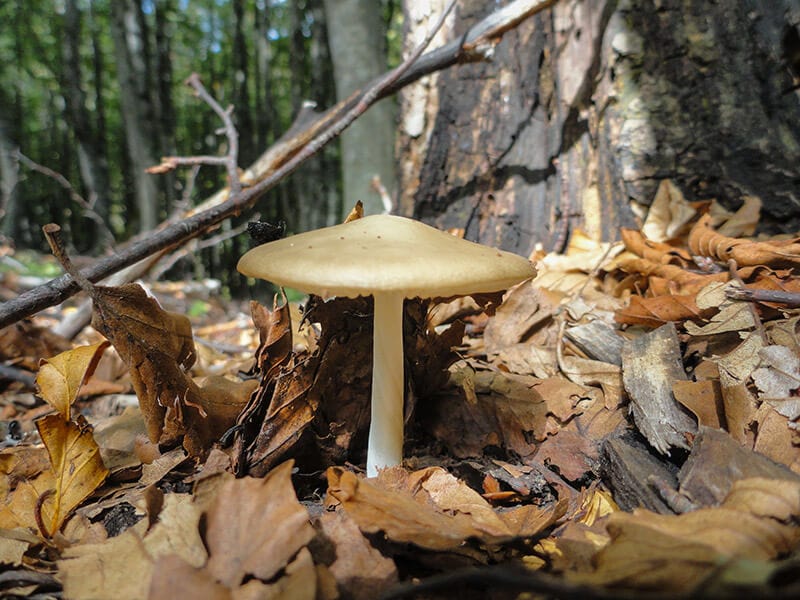
Mostly found in Asia, Europe, and North America, Wood Pinkgill is another toxic mushroom that causes many gastrointestinal symptoms.
They typically grow in a large group in deciduous broad-leaved trees or under hardwoods. To identify Wood Pinkgill, you should remember these key characteristics.
They have a convex cap in beige color or can turn to paler color when drying out. The gill is white at first, then turns to pink when aged. The stem is smooth in a white hue without any stem ring.
They are very easy to mistake for edible mushrooms. In reality, Wood Pinkgill is 1 of Japan’s 3 most common causes behind fungi poisoning.
43. Woolly Milkcap (Lactarius Torminosus)
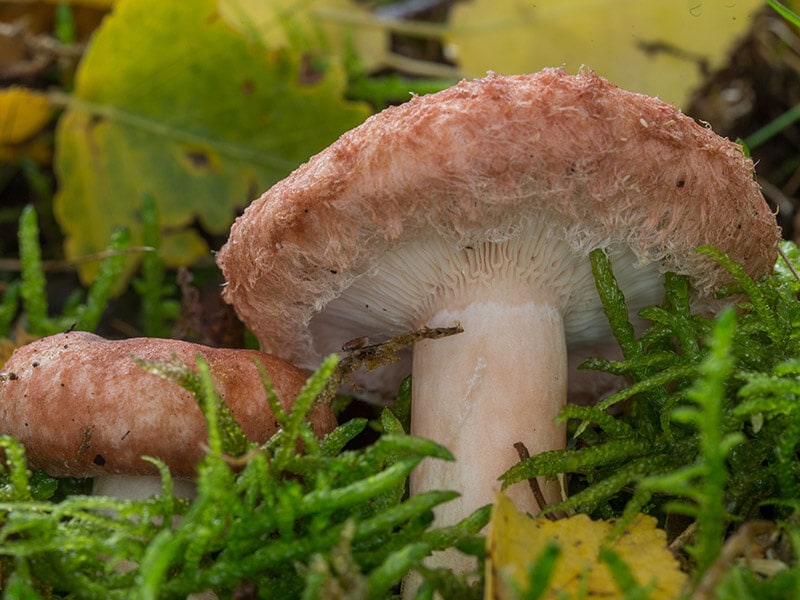
Woolly Milkcap’s distribution is diverse, including North America, North Africa, Europe, and North Asia. And they can develop on grassy sites or in the woodland.
Overall, they look very attractive with a big wooly cap and thick flesh in pink-orange to pale pink color. When mature, the outer edges of the cap can rise a little bit to create a shallow-funnel shape and have a strong peppery taste.
However, the edibility of this mushroom is still in debate. Some reports prove they are poisonous species that can result in mild to fatal gastroenteritis, particularly when consumed raw.
But in some countries, locals use them to make pickles or salted dishes as they like the inherent hot acrid taste of Woolly Milkcap.
44. Yellow-staining Mushroom (Agaricus Xanthodermus)
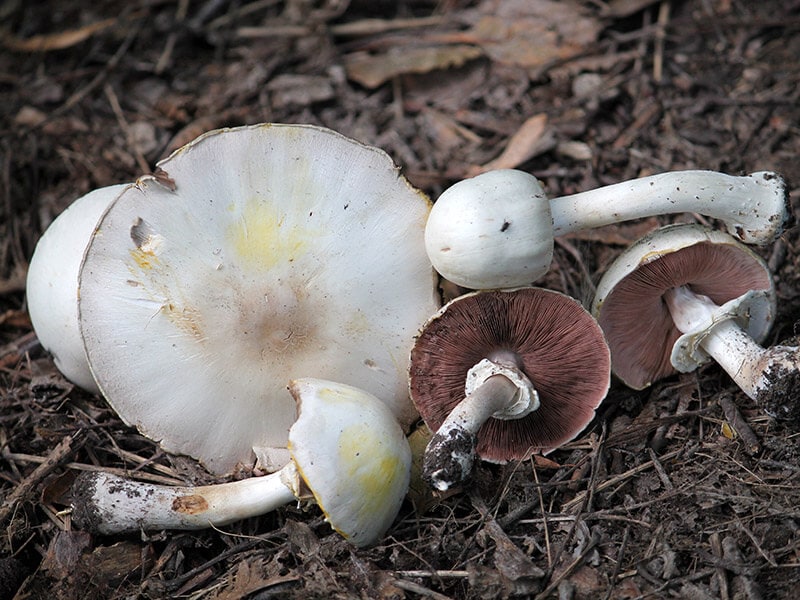
Yellow-staining mushroom grows in clusters in garden beds or in a grassy environment. They are a widespread species that you can see in many countries/regions, for example, Europe, southern Africa, North America, or West Asia.
The fungus cap is 2 to 6 inches in diameter with white color and a few brown tints in the center. Their stipe is also white and ranges from 2 to 5 inches tall.
For easier identification, you can check its base by cutting it, which causes the mushroom to immediately turn into a bright color. After that, it might fade into a dull-brown hue.
In terms of smell, yellow-staining mushrooms have an unpleasant odor, especially in the stem’s base area. There are some records that some people can eat this mushroom safely; however, it is still a poisonous one that can result in several gastric issues.
45. Funeral Bell (Galerina Marginata)
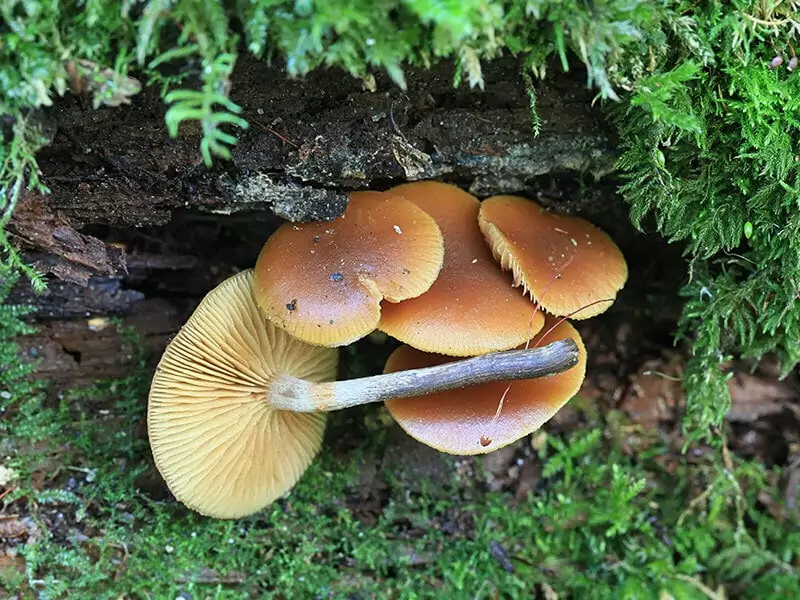
The last one is an extremely dangerous mushroom containing deadly amatoxin properties. No doubt, the other names of this mushroom sound quite scary, such as Dealy Skullcap or Deadly Galerina.
They grow on the stumps of broad-leaved trees or conifer stumps that you can spot throughout the Central and Northern mainland of Europe, North America, Asia, or Australia.
The toxin in Funeral Bell is amatoxins. It can cause diarrhea, vomiting, hypothermia, and liver damage. If the patient is not treated immediately, these severe symptoms can get worse and lead to death.
So how does it look? Funeral Bell has a brown to yellowish-brown cap with brow gill. The cap surface is relatively smooth and the gill is quite narrow. To the untrained eye, they might look like the Honey mushroom (Armillaria mellea), which is an edible wild mushroom.
So if you are not sure what mushroom variety you just have found, please do not consume it.
Mushrooms Can Be Superfoods, But Make Sure They Are Edible First!
Indeed, there are many toxic or inedible mushroom varieties that can lead to several gastrointestinal symptoms. Or worse, it can destroy your liver or kidney function and might result in death if not treated immediately.
For safe consumption, you should only consume commercial mushrooms sold in markets or supermarkets. Do not eat wild mushrooms if you are not a mushroom expert because many poisonous varieties might look like edible ones.
Finally, I hope you have gained some helpful knowledge regarding mushrooms through their information and pictures. If you still have other questions, please leave your comment below. And if you like my post, your like and share is my big motivation for more practical articles like this.
